Should you really install a campervan induction hob?
When converting a van, lots of people consider installing an induction hob as their campervan cooker. And why wouldn’t you? You can rely purely on solar as a free source of energy, induction hobs are pretty cheap, and you don’t need to worry about where to fill up.
However, what many people don’t realise is just how much power an induction hob uses, even when cooking for a short amount of time. Since we started our business designing campervan electrical systems, we’ve had countless people asking to include an induction hob as their campervan cooker.
That’s why we decided to write this article, to explain exactly how much power an induction hob uses, and whether or not it’s viable to install one in a campervan.


How much power does a campervan induction hob use?
First, it’s useful to do the maths to explain exactly how much power a campervan induction hob uses. A ‘lower wattage’ camper induction hob has a maximum wattage of around 1500W-2000W. Some campervan and motorhome manufacturers such as Thetford and Sterling make induction hobs ‘so say’ specifically designed for use in a campervan. The Sterling Power IH1 single ring induction hob has a maximum wattage of 1500W, and the Sterling Power fixed twin induction hob (available in side-to-side or front-to-back models) has a maximum wattage of 2800W.

Sterling Power IH1 single ring induction hob
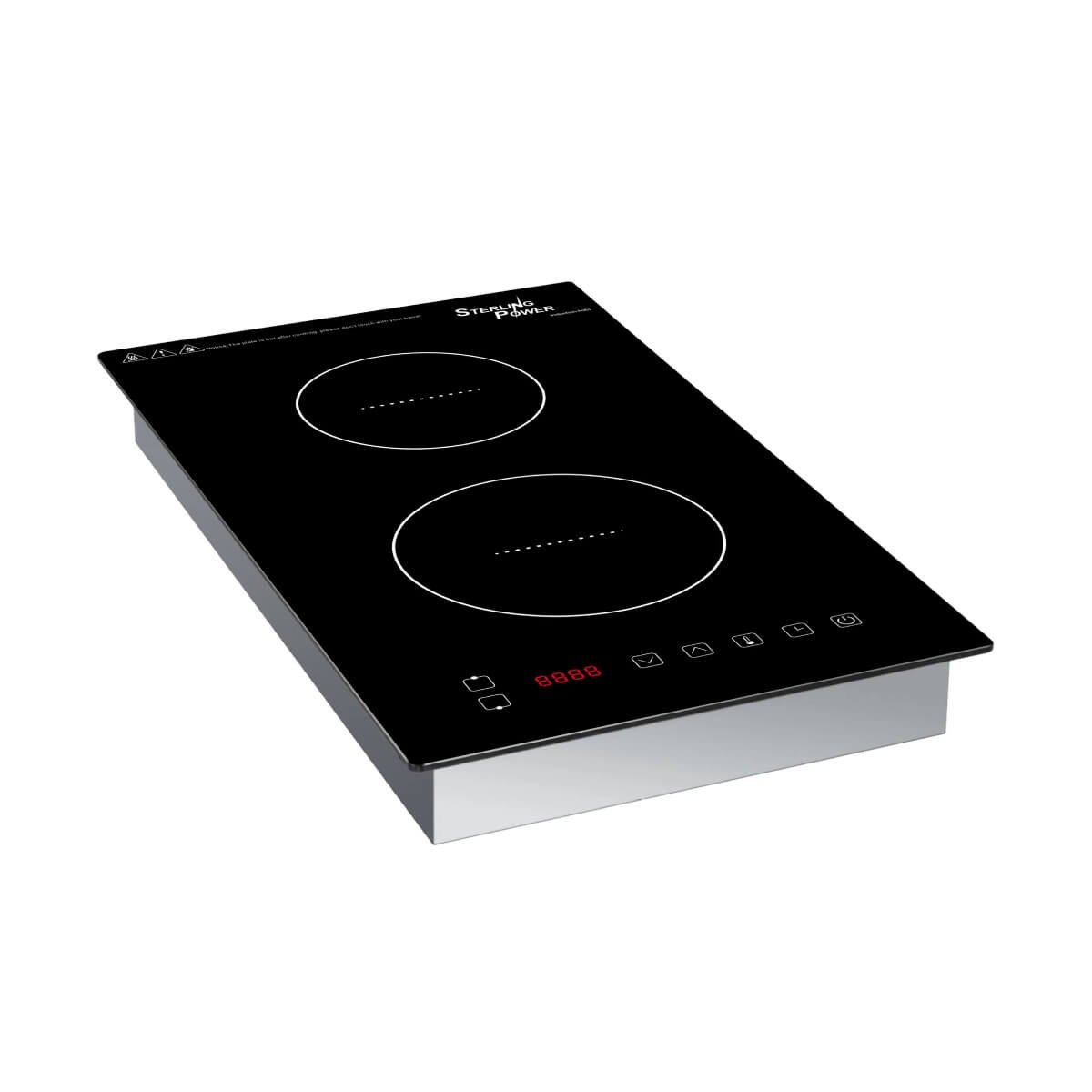
Sterling Power twin front-to-back induction hob
If you’re considering installing a domestic induction hob, a 4 ring hob can boast a whopping 6400W rating, more than double the largest 12V inverter available, so you’re best opting for a low wattage model designed specifically for a campervan if you do go down the induction route.
We’ll calculate the power required to power a camper induction hob based on two use cases: use case 1 is someone with low usage, and use case 2 is someone with usage more similar to how you would use your hob at home. For both use cases, we’ll calculate the total watt hours needed to power the induction hob, and from that we can derive the total amp hours used. We’ll base the calculations on a single ring 1500W hob.
Use case 1 – low usage
Breakfast
Boil a pan of water for tea/coffee – 1 ring on high heat for 5 mins (where high heat = 1500W)
5 ÷ 60 = 0.083 hours
1 ring x 0.083 hours x 1500W = 124.5Wh ÷ 12V = 10.5Ah
Lunch
Sandwich – no stove required
Dinner
Basic pasta meal – 1 ring on medium heat for 20 mins (where medium heat = 1000W)
20 ÷ 60 = 0.33 hours
1 ring x 0.33 hours x 1000W = 330Wh ÷ 12V = 27.5Ah
Total power used
10.5Ah + 27.5Ah = 38Ah per day


Use case 2 – ‘normal’ usage
Breakfast
Boil a pan of water for tea/coffee – 1 ring on high heat for 5 mins (where high heat = 1500W)
5 ÷ 60 = 0.083 hours
1 ring x 0.083 hours x 1500W = 124.5Wh ÷ 12V = 10.5Ah
Porridge – 1 ring on medium heat for 5 mins (where medium heat = 1000W)
5 ÷ 60 = 0.083 hours
1 ring x 0.083 hours x 1000W = 83Wh ÷ 12V = 7Ah
Lunch
Tin of soup – 1 ring on high heat for 5 mins (where high heat = 1500W)
5 ÷ 60 = 0.083 hours
1 ring x 0.083 hours x 1500W = 124.5Wh ÷ 12V = 10.5Ah
Dinner
Curry with tofu, vegetables & rice – 1 ring on medium heat for 20 mins & 30 mins (where medium heat = 1000W)
(20 + 30) ÷ 60 = 0.83 hours
1 ring x 0.83 hours x 1000W = 830Wh ÷ 12V = 69Ah
Total power used
10.5Ah + 7Ah + 10.5Ah + 69Ah = 97Ah per day
Wattage vs cooking time
You may think that you can simply install a lower wattage induction hob, or cook on a lower wattage to use less power. However, this is not the case. If you cook on a lower wattage, it will simply take longer to cook.
When boiling 1 litre of water on a 1800W induction hob, at the max 1800W setting it will take 4 minutes to boil, whereas on 50% heat at 900W it will take 8 minutes. This shows that it’s not a case of just using a lower setting, you ultimately need to use the setting required to adequately cook the meal you are preparing.
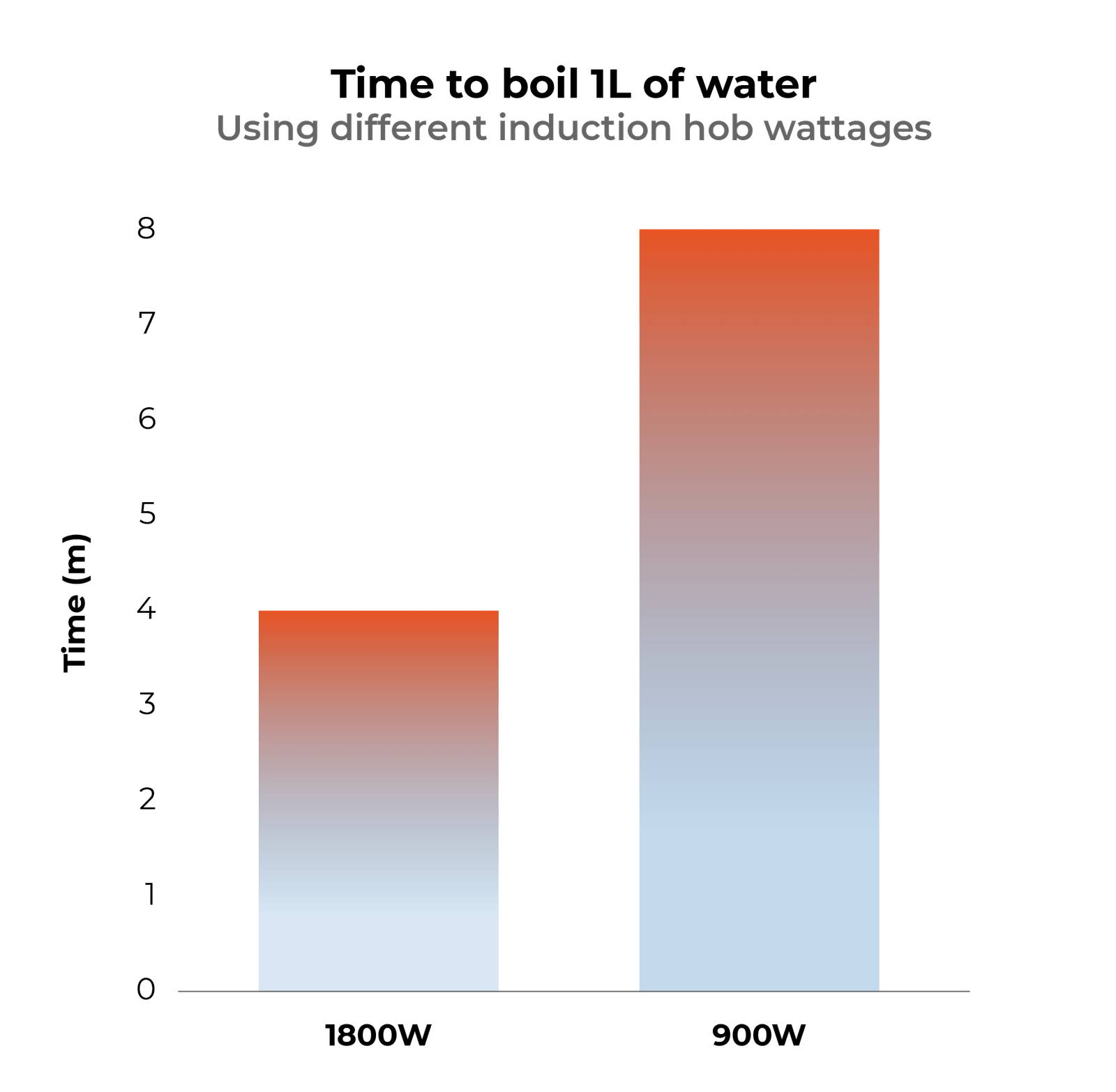
Using a campervan induction hob on hookup vs off-grid
So now that we know how much power an induction hob in a campervan uses, we can see if it’s possible to install one as part of your electrical system. Ultimately, much of this will depend on how you plan on using your campervan. Whether you will spend your time mainly on campsites or fully off-grid will have a massive impact on your system.
For those who will exclusively use campsites, it almost doesn’t matter how much power you use (within reason). When you’re connected to a campsite hookup, your power comes directly from the campsite power supply rather than your leisure batteries. This means that you have an almost endless supply of power whilst plugged into hookup.
The caveat to make here is that campsites have hookups rated to 16A, so you will only be able to access a maximum wattage of 16A x 230V = 3680W. If you use any more than this, you will trip the campsite post (i.e. blow the fuse inside the hookup) and likely get charged by the campsite to turn this back on. Therefore, even if you plan on spending all of your time on campsites, you should ensure that your total power usage doesn’t exceed ~3000W.
However, if you plan on spending your time split between campsites and off-grid, or even fully off-grid, then you’ll need to ensure that your system has enough battery capacity and a big enough inverter to power your induction hob for a few days.
Before we go any further with our calculations, you should note that the following information is based on campervans with a diesel or petrol engine. If you have an electric van, your campervan electrics will work a bit differently. As a result, the potential to use an induction hob becomes much more favourable. If you want to know more, we’ve included a section further down where we consider the possibility of using induction hobs in electric campervans.
What electrical system do you need to run a campervan induction hob off-grid?
We usually recommend to everyone spending time off-grid that they have a battery bank big enough to give them at least 3 full days of power usage without charging, as this allows for days of poor weather and little driving (i.e. no charging via solar or using the alternator). Obviously this will vary massively based on your other non-cooking power usage, but so we have something to work with, we’ll base it on an average daily power usage of 60Ah (2x phones, 1x laptop, fridge, spotlights, water pump, diesel heater, WiFi router, speaker).


It’s also important to explain at this point why you can’t use AGM to power an induction hob. Although it is technically possible, you will encounter something called the Peukert Effect. This means that as you increase the discharge current (i.e. you discharge the battery quicker due to a high wattage appliance such as an induction hob), the battery capacity also decreases. This is because the battery capacity specified by a manufacturer is the C20.
The C20 indicates the power a battery can deliver continuously for 20 hours (i.e. after 20 hours, a 200Ah battery would have 0Ah of charge left). So for a 200Ah battery, a 10A load would take 20 hours to discharge it. This means that if you put a load larger than 10A through a 200Ah battery, for example a 20A load, it wouldn’t take 10 hours to discharge it, it would actually take much less than this.
We recognise that this is quite confusing, however what it ultimately means is that you should only use lithium if you’re installing in induction hob, as if you install an AGM battery bank, you will be accessing much less capacity than the advertised Ah rating of your battery.
Calculating system requirements
Use case 1 – low usage
🔋 Battery capacity
If you have low usage and you’re using 38Ah per day to cook, you will have a total power usage of:
60Ah + 38Ah = 98Ah per day

For 3 days off-grid, this would mean you would need:
3 days x 98Ah = 294Ah usable capacity
For a lithium battery bank with 95% usable capacity:
294Ah ÷ 0.95 = 310Ah lithium battery bank required
⚡ Inverter
Depending on the induction hob you install and your other appliances, you would also need to install either a 2000W or 3000W inverter.
☀️ Solar & charging
To recharge a battery bank around 300Ah, you would likely need around 300W-400W solar, depending on if you would occasionally spend time on campsites (and subsequently connected to hookup to recharge), or if you would be fully off-grid.
Total system cost
The total cost of an electrical system with this spec would be around £4,800-£6,600.
Use case 2 – ‘normal’ usage
🔋 Battery capacity
If you have low usage and you’re using 97Ah per day to cook, you will have a total power usage of:
60Ah + 38Ah = 157Ah per day
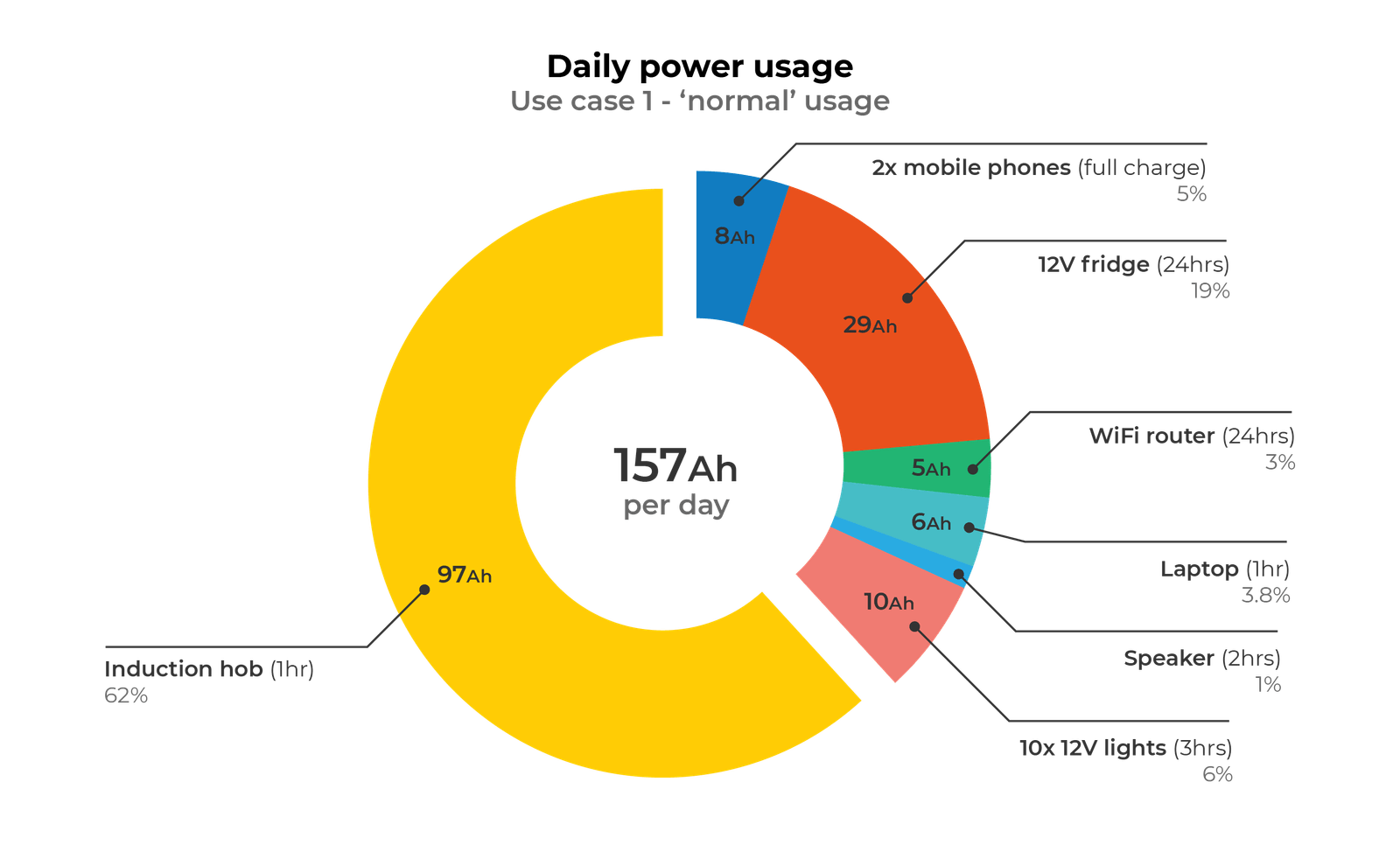
For 3 days off-grid, this would mean you would need:
3 days x 157Ah = 471Ah usable capacity
For a lithium battery bank with 95% usable capacity:
471Ah ÷ 0.95 = 496Ah lithium battery bank required
⚡ Inverter
Depending on the induction hob you install and your other appliances, you would also need to install either a 2000W or 3000W inverter.
☀️ Solar & charging
To recharge a battery bank around 500Ah, you would likely need around 400W-600W solar, depending on if you would occasionally spend time on campsites (and subsequently connected to hookup to recharge), or if you would be fully off-grid.
Total system cost
The total cost of an electrical system with this spec would be around £6,400-£8,600.
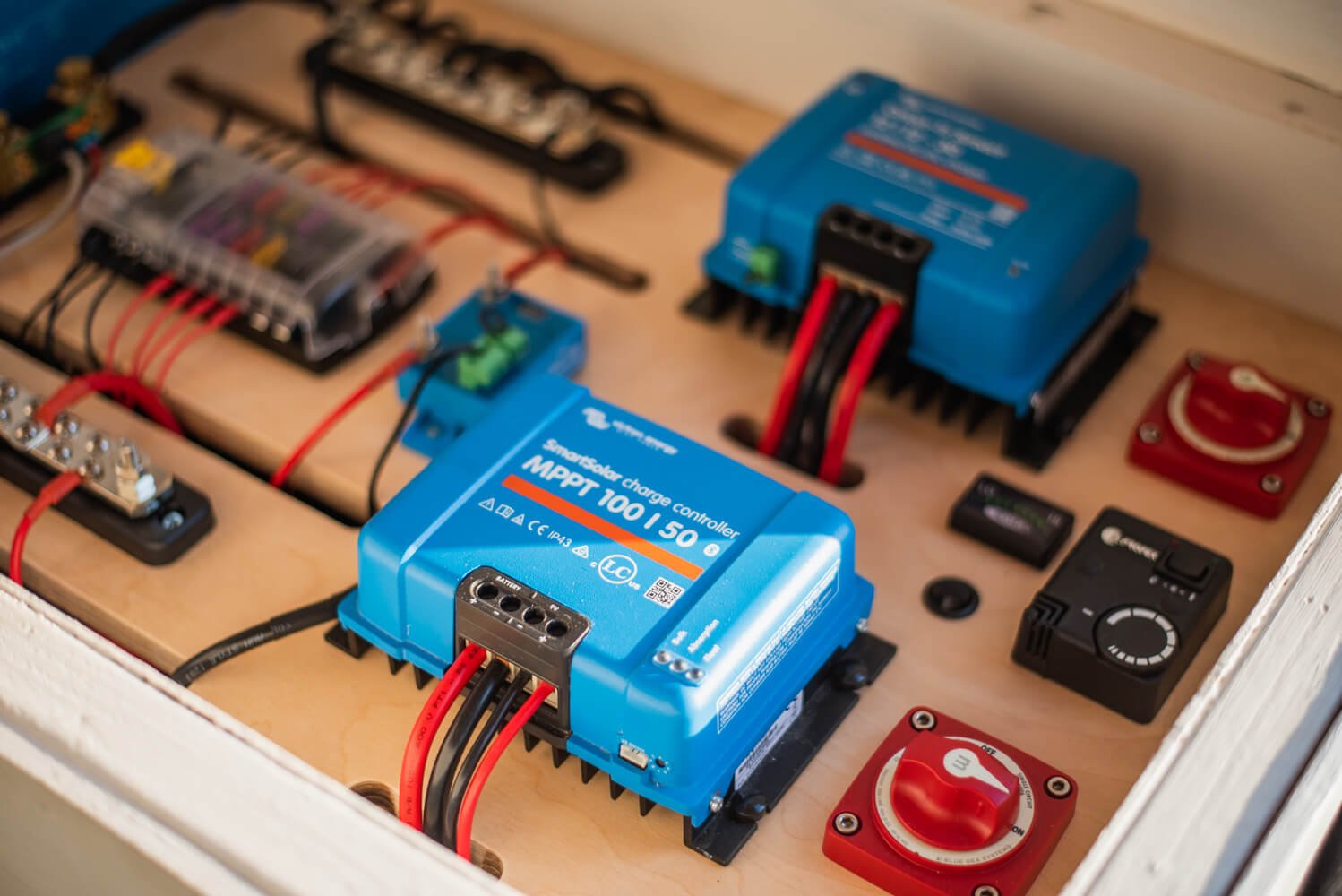
A large lithium battery bank, a large solar array and a high rated inverter are all required to run an induction hob in a campervan
Of course, these values are fairly loose, as there are a lot of factors that affect total system cost. For someone living in their van full-time completely off-grid with other high wattage appliances such as a hairdryer, the total system cost could be higher again.
Equally, someone with much lower power usage, only using their van for weekends away and recharging at a campsite every couple of days, the cost of the system could be lower. These costs are meant to just give an indication of the cost of installing an induction hob in your campervan.
Here are some example systems that may be suitable to power an induction hob (although it’s important you calculate your power usage correctly to ensure your battery bank and recharging methods are adequate):
If you do want to install induction in your campervan, we can help you design a bespoke electrical system with suitable requirements for your power usage.
Campervan electrics leaving you confused?

Induction hobs vs LPG hobs in a campervan
To give some context, we wanted to provide a comparison with cooking on gas. Although many are worried about installing gas in their campervan, provided it’s done correctly, it is completely safe. LPG can be a cheap fuel source that you can use to cook on, as well as heat water and your campervan.
If you’re worried about installing an LPG system yourself, you can pay a professional to do this for you. The cost of this is around £800-£1,000.
Filling a 25L underslung gas tank costs around £15 and lasts for around 3 months based on full-time usage for both cooking and as a heating source.
So, from a purely financial point of view, a gas campervan cooker is certainly the cheaper option, as your requirements for your electrical system will be much lower.
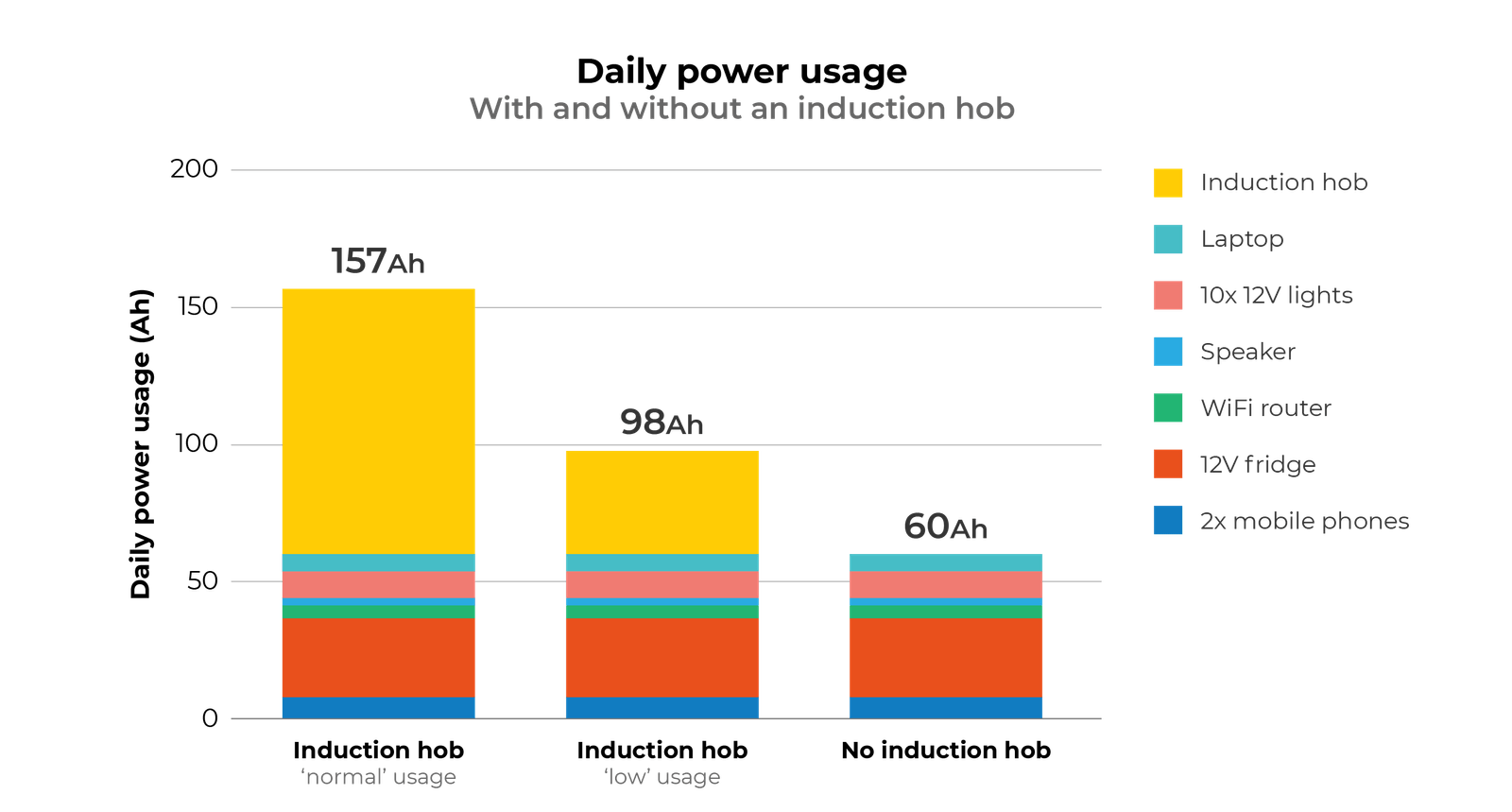
The other benefit of LPG is that once your gas tank is full, it lasts for many months. So you won’t need to closely monitor your battery level each time you want to cook, but can instead cook whatever you fancy, whether that’s a tin of soup or a big roast dinner.
The downsides of cooking on gas are that it can be harder to fill up when you’re on the continent, and this is the reason that some people want to install induction. We’ve been living in our van full-time for the past 7 months travelling around Europe and we haven’t had any issues filling up in France, Switzerland or Spain with a set of simple adapters. However, it is something to be aware of depending on where you’ll be travelling.
Induction hobs can also be the more sustainable option if you’re able to charge purely from solar. However, most people won’t rely fully on solar to charge, and will also use the vehicle’s alternator whilst they drive, or shore power – neither of which are that eco friendly!
We spoke to Will and Ceri from tothemountainsandback who have an induction hob in their van to find out their thoughts on using electricity to cook in a campervan.


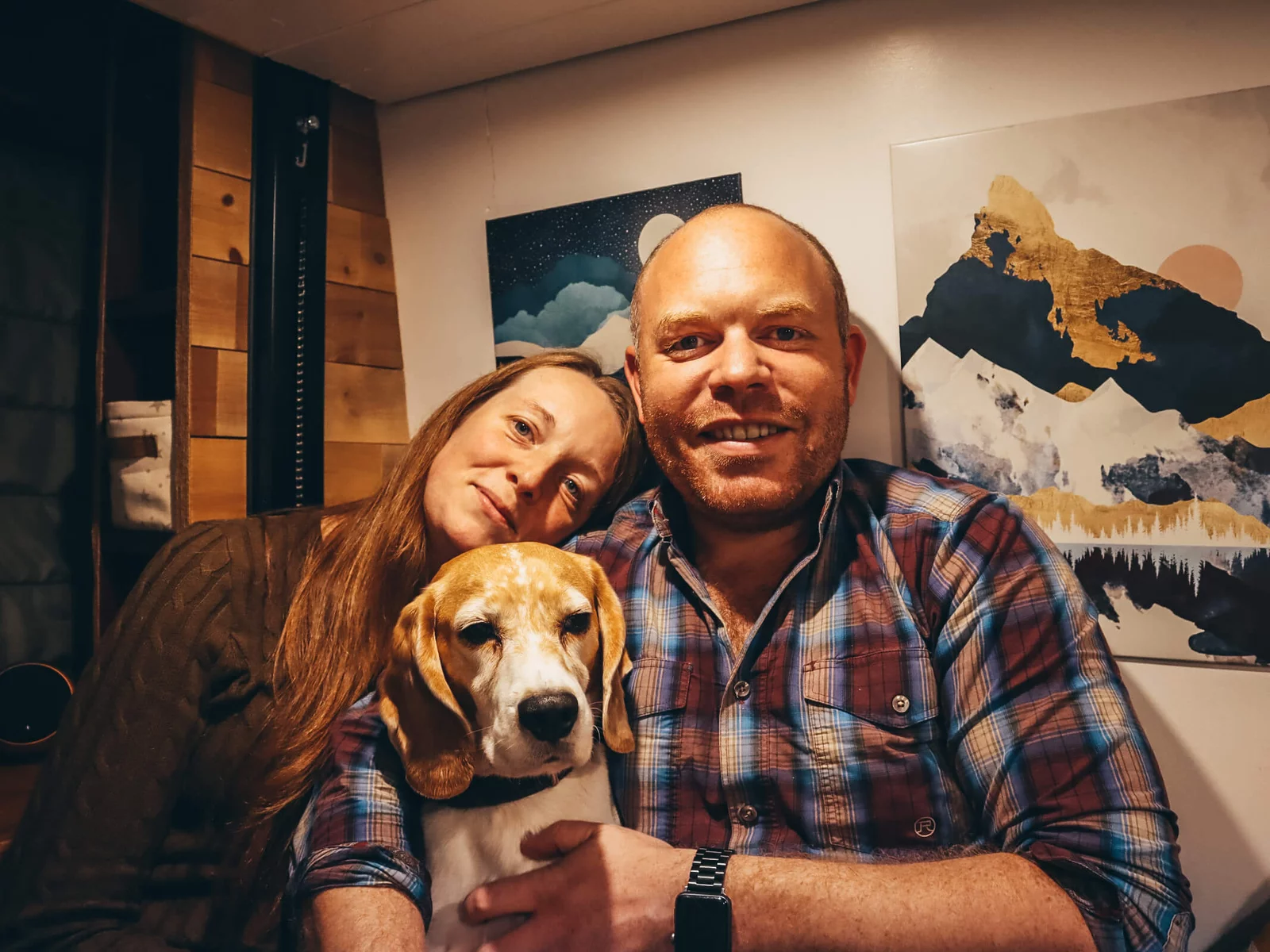
I (Ceri) was determined from the beginning we weren’t having gas so after looking into all the options available, we decided induction was the best solution. A few people thought this was crazy, especially as we travel a lot in winter for skiing, so solar isn’t always easy to come by. It definitely uses a lot of power but it’s manageable as long as you have a good electrical system.
It’s also vital to have multiple charging options – we can charge via solar, from the van engine whilst driving and shore power. We drive most days as this is the kind of travel we prefer which works well for keeping our battery topped up. If we want to stay somewhere for more than a couple of days, we would need to plug in unless there’s plenty of solar.
We’re huge fans and despite the above cons we’ll definitely install induction again if we ever do another van conversion!
Ceri, @tothemountainsandback
Using induction in a campervan – the verdict
Ultimately, most people are going to sit in the use case 2 – ‘normal’ usage when it comes to cooking in a campervan, and therefore will need a very high spec electrical system to run an induction hob. It is totally possible to run induction in a van, but it just means you will end up spending a lot of money on your electrical system, and you will need to always be aware of your power usage.
If you’re cooking on induction, we’d recommend that you regularly check the state of charge of your batteries. If you have the Victron Smart Shunt or the Victron Smart Battery Monitor, you can check your state of charge via the app which is really handy. By checking the level of your batteries before and after you use your hob, you can see exactly how much power you’re using each time you cook a meal.
If your state of charge is getting low, you will need to either plug into hookup, go for a drive, or opt for an uncooked meal until your batteries have recharged sufficiently.
If you can afford the high spec electrical system required to run an induction hob and you’re aware of its limitations, then it is ultimately possible. However, for most people, it’s likely that gas will be the better option for your campervan cooker.
However, if you’re converting an electric van, then the considerations are slightly different…
Induction hobs in electric campervans
Throughout this article, we’ve been a little sceptical about using induction hobs when you’re off-grid. However, when it comes to electric campervans, the numbers become a little more favourable.
In every electric vehicle, there is a large traction battery which stores electrical energy. And in comparison to a typical leisure battery, these traction batteries have a massive storage capacity.
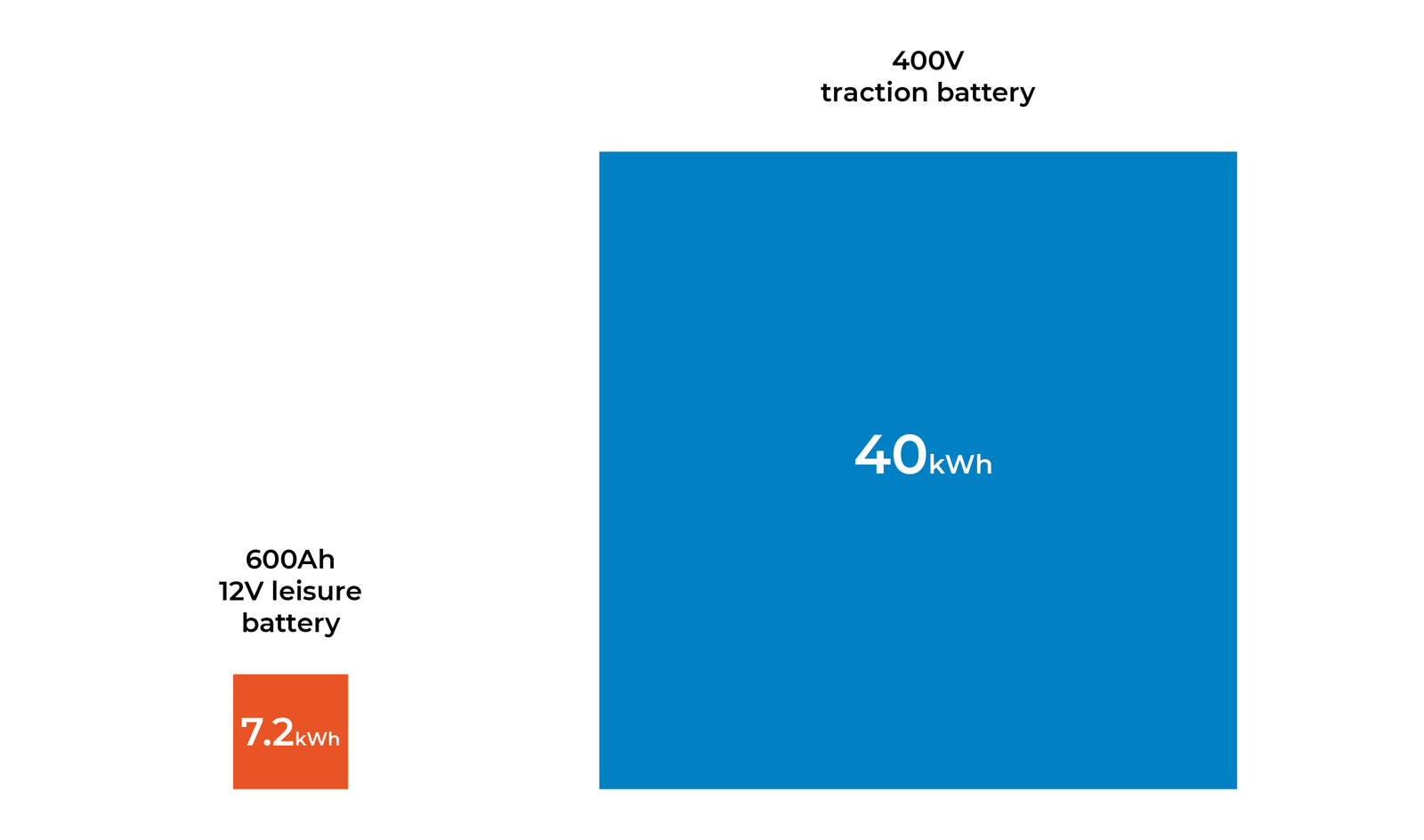
In an electric campervan, we can tap into this big energy store to help power the campervan electrics. With the right wiring, power from the traction battery can be used as a charging source for the leisure battery.
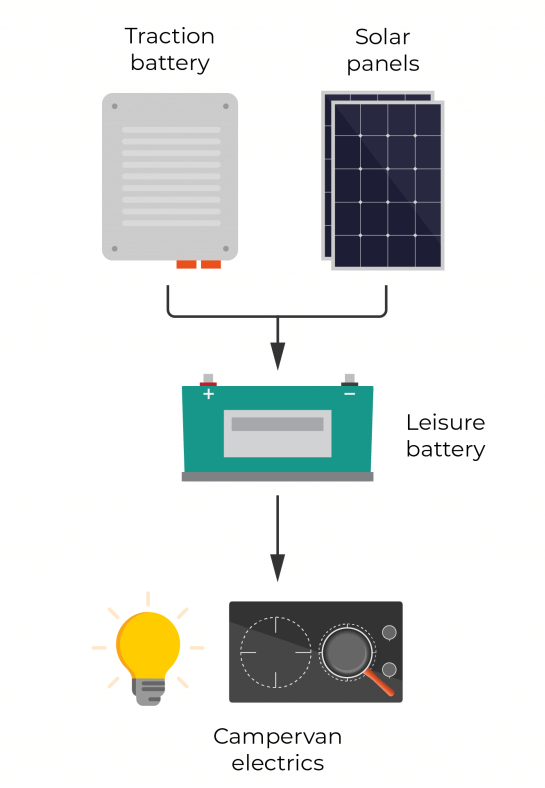
Consequently, EV campervans actually have a massive supply of power with them at all times. This makes it much easier to power an induction hob off-grid, without the need for a massive leisure battery and large solar array.
How to power an induction hob in an EV campervan
When off-grid in an EV campervan, you can power an induction hob from a leisure battery via an inverter, just like in a conventional campervan. What’s different is the way in which you charge the leisure battery.
In diesel and petrol vans, an alternator is used to transfer power from the engine to the starter battery, but electric vehicles use a DC-DC converter. This DC-DC converter charges the low voltage starter battery from the high voltage traction battery. Subsequently, this charge passes along to the campervan’s leisure battery using a battery to battery charger.
The flow of power looks something like this:

In a diesel or petrol van, the van must be driving to initiate this kind of charging. But in an EV camper, just turning the vehicle on activates the DC-DC converter. Remember, this doesn’t mean you have to sit in the rumble of a running engine – EV’s are practically silent when they’re turned on.
This concept might seem like a magical solution to campervan power, but there is one drawback – using power from the traction battery will shorten the vehicle’s range.
With the current state of technology, the range of electric vans is significantly less than that of diesel or petrol vans. Moreover, the sparse distribution of charging stations and slow charging times can make it difficult to travel remotely or spontaneously. As a result, every drop of your precious battery power is going to be important.
Have a read of our electric campervan article if you want to know more about the capabilities of electric vans and the differences between electrical systems in EV vans and combustion engine vans.
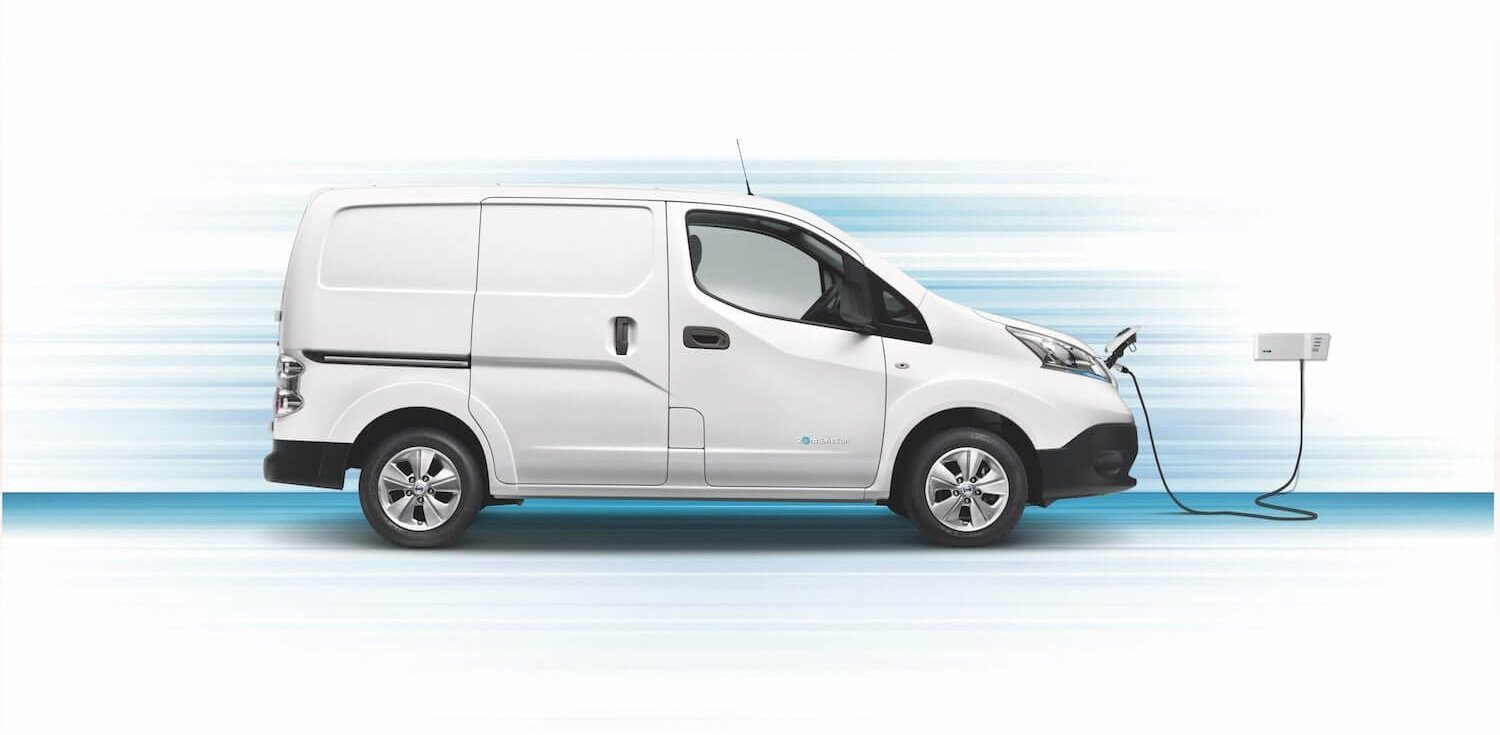
The e-NV200 has been around since 2014 and is a popular choice for electric campervan conversions
How much will an induction hob affect my vehicle’s range?
We’ve already calculated how much energy an induction hob will use on a daily basis, so let’s see how that power draw affects the range of an electric van.
Example case – Induction cooking in an EV
A popular electric van to convert is the Nissan e-NV200, which has a 40kWh traction battery. With this battery bank, the e-NV200 has a theoretical driving range of 124 miles.
For a ‘normal use’ case, like the one we calculated above, induction cooking results in a daily power draw around 157Ah. This is equivalent to around ∼2kWh per day. This extra 2kWh of power draw would reduce the e-NV200’s 124 mile range by approximately 6 miles every day.
This small impact of 6 miles per day doesn’t seem too significant. However, if you want to explore remote areas on your trip, charging stations might be few and far between, and you’ll want your EV battery to last as long as possible. To reduce the impact on the vehicle’s range, you can include solar panels in the electrical system.

Solar panels are a must-have if you want to last off-grid as long as possible
Example case – Induction cooking in an EV with solar power
Let’s calculate how much of that 2kWh daily power usage could be offset by solar power. There are lots of variables to consider here, but to give you an idea, we can consider one specific example.
Let’s say you have space for two 175W solar panels on your campervan roof. From the wattage of these panels, we can use Victron’s calculator to estimate the potential daily solar yield. On a clear summer day in the UK, these panels will generate around 1kWh of power.
In other words, a 350W solar array would cover approximately half of this campervan’s daily power usage when using an induction hob. The traction battery could provide the remaining 1kWh of power required, which would reduce the e-NV200’s range by only 3.1 miles every day.
The results of this calculation will vary significantly in different circumstances. So, run through the numbers yourself to calculate the viability of an induction hob in your campervan. Consider how much space you have on your roof, how much the weather or location will affect your solar production, and how long you might use the induction hob for each day.
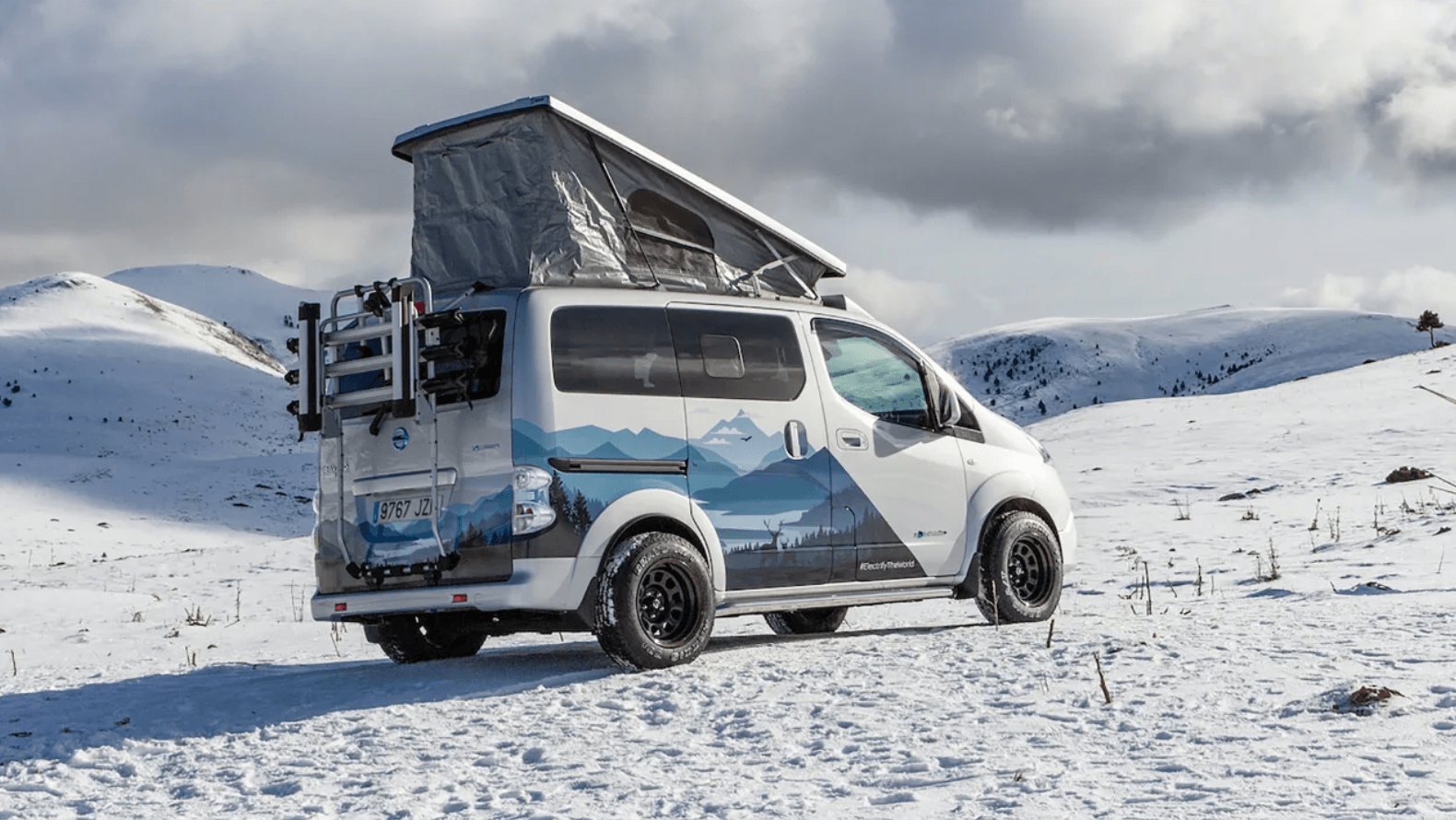
Nissan have produced a concept van of the e-NV200 kitted out for winter exploring
Can you use an induction hob in an EV campervan?
Induction cooking is much more feasible in an electric campervan. In fact, the massive store of power in the traction batteries could theoretically power the campervan for weeks off-grid! And from the simple examples considered above, the driving range won’t be affected too significantly, especially when solar power is used to supplement the daily power usage.
Nevertheless, there are still some big costs involved with off-grid induction cooking. Even in an EV campervan, you’ll still need a large campervan inverter and a lithium battery to handle the high current.
For those loking to convert an EV campervan, we’d suggest including enough battery capacity to cover a full day of power usage. This should include your induction hob and any other appliances you will use. Then, include a solar array large enough to fully recharge this battery bank in a day. This will ensure you avoid eating into your vehicle’s mileage as much as possible.
Best low wattage induction hobs for campervans
When you’re trying to choose an induction hob for your campervan, you want to find something which is good quality, energy efficient and easy to use. There are a few good brands out there, but we think Sterling Power produce the best induction hobs for campervans.
We like Sterling Power because their hobs have been carefully designed, specifically for campervan cooking. They are a British, family-owned company, and their low wattage induction hobs have a couple of really useful features.
Automatic shut-off
Sterling Power induction hobs will automatically turn off after 1 minute if no pan has been detected on the surface. Therefore, if you leave the hob on accidentally, this feature will help you save power.
Electrical safety
Every Sterling Power hob has an over-heat, over-voltage, and over-current protection mechanism. Knowing these safety features are in place will give you peace of mind as you cook.
Power monitor
This is our favourite feature – every Sterling Power induction hob has a screen which displays your power consumption. This will be especially useful if you’re planning to use the hob when you’re off-grid. For example, knowing the power usage will help you preserve battery life and make sure you don’t exceed the rating of your inverter.
No power surge
The problem with most domestic induction hobs is the high power surge which occurs as they’re trying to heat up. This spike in power is often much larger than the actual power rating given by the manufacturer. As a result, you would need to install a large (and expensive) inverter to handle this high power draw.
In contrast, Sterling Power induction hobs are designed to slowly ramp up the wattage, without a big spike in power. For this reason, a smaller inverter can be used, which can save you a big chunk of your budget.
Induction hob
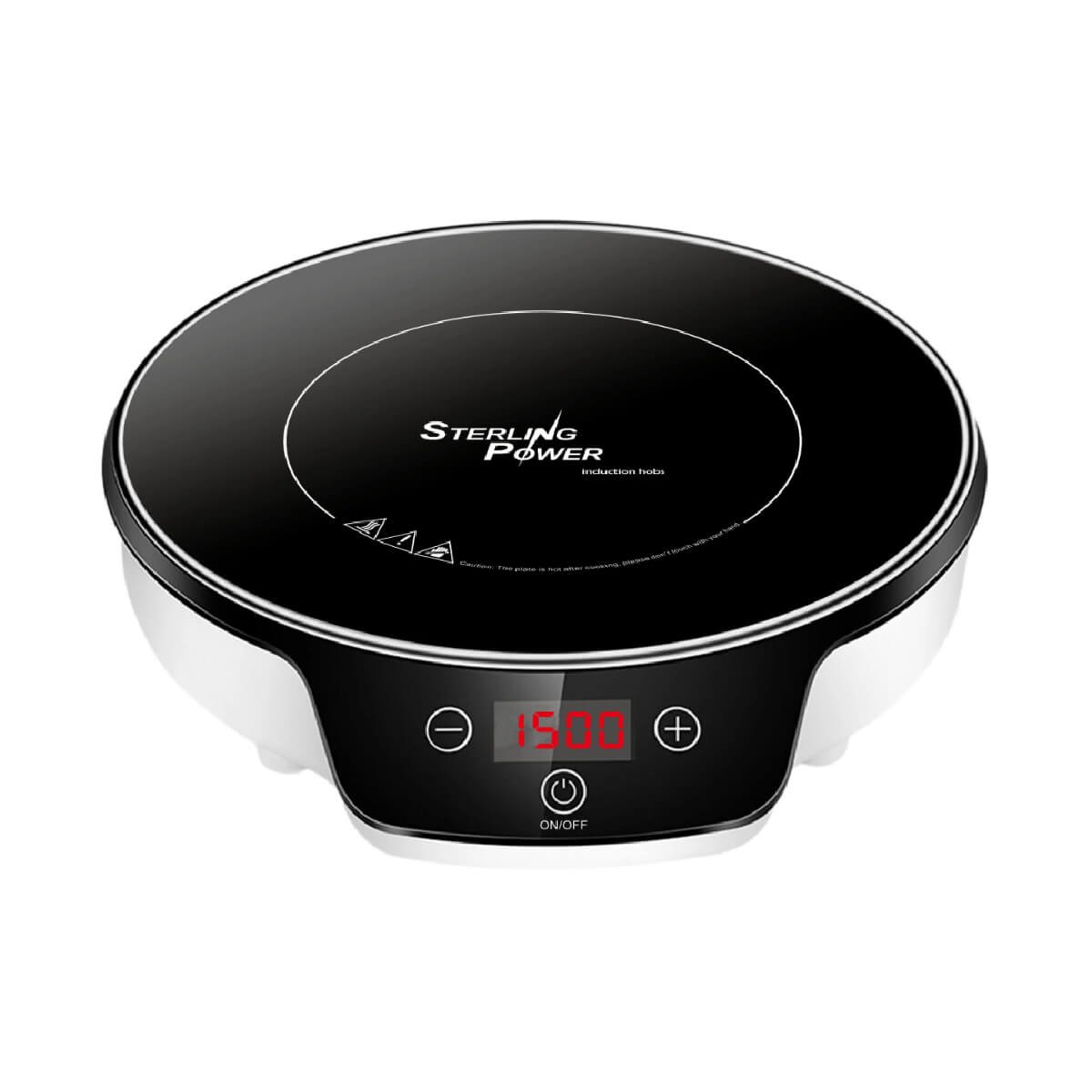
1500W single ring portable induction hob
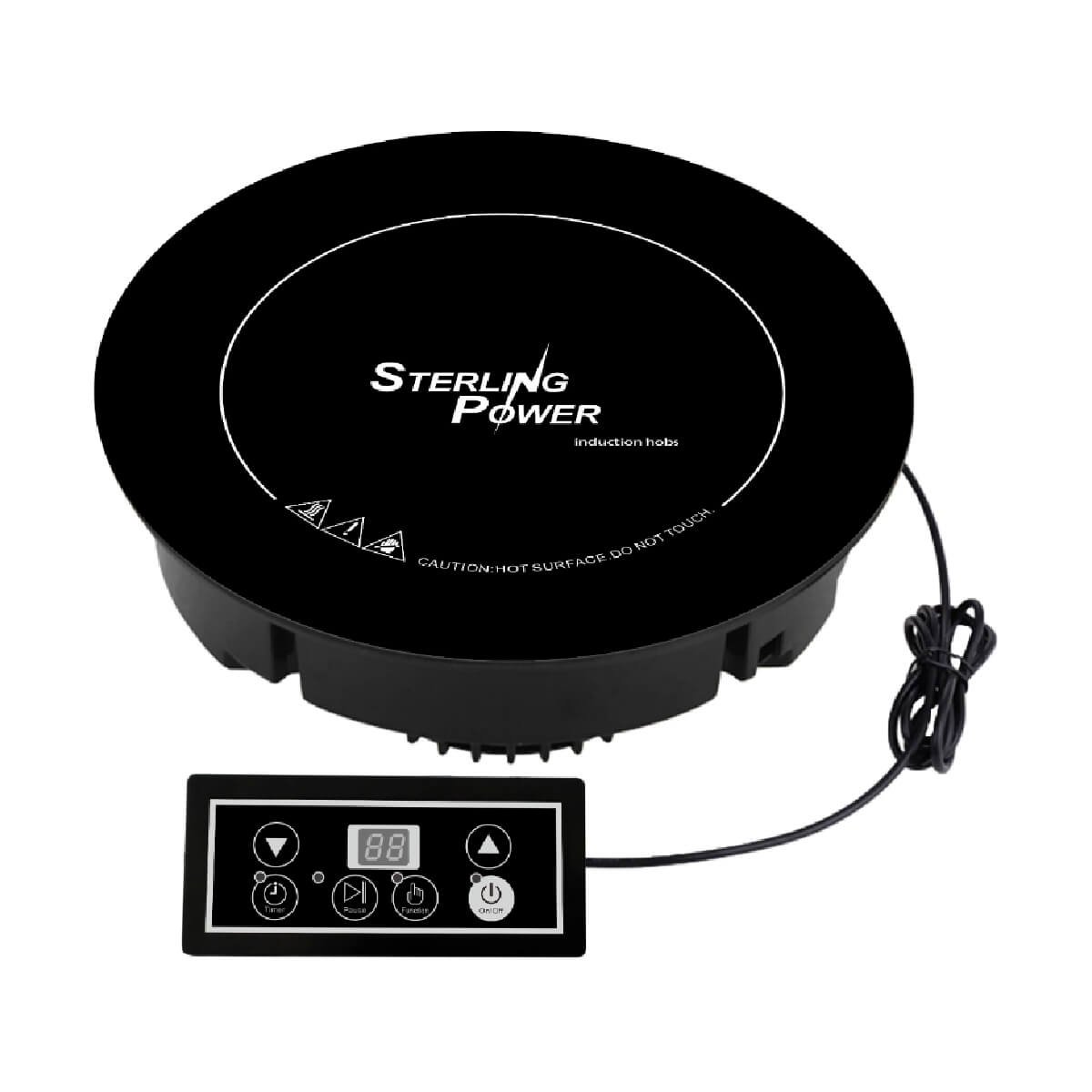
1500W single ring fixed induction hob

2800W double ring fixed induction hob
Minimum inverter size
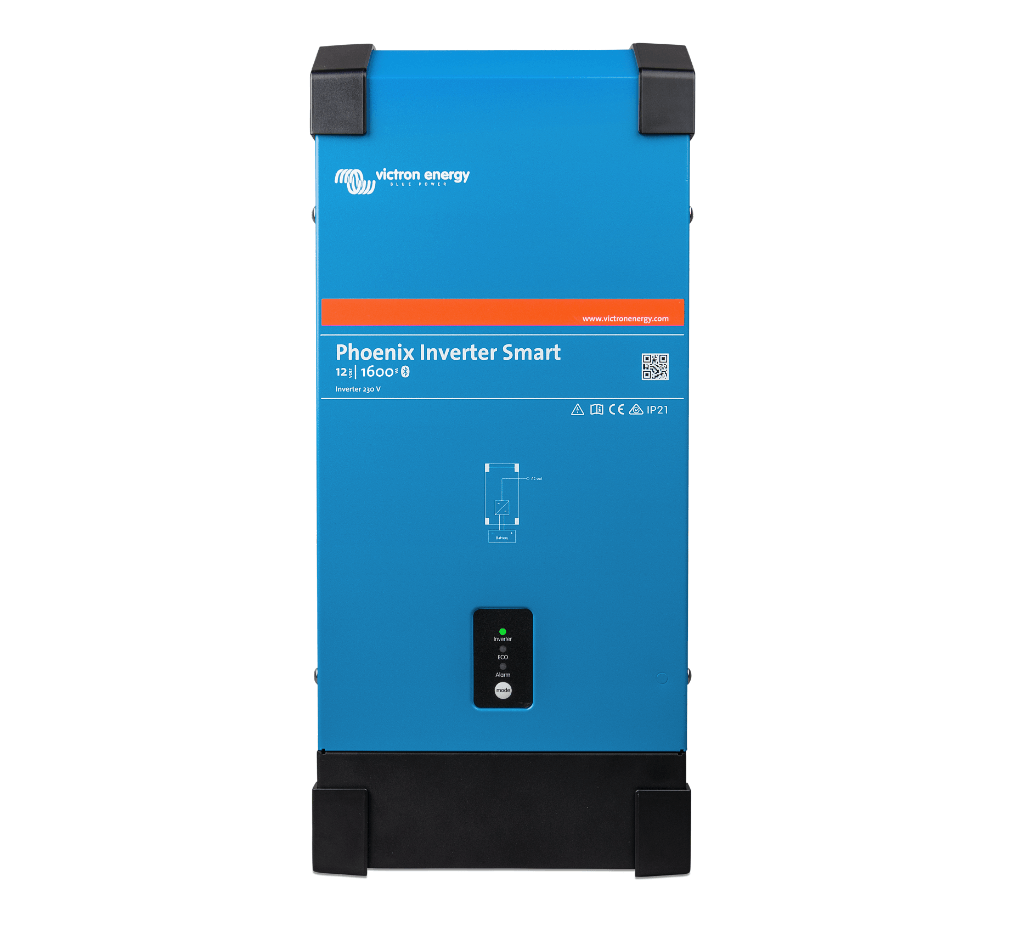
1600VA inverter

1600VA inverter
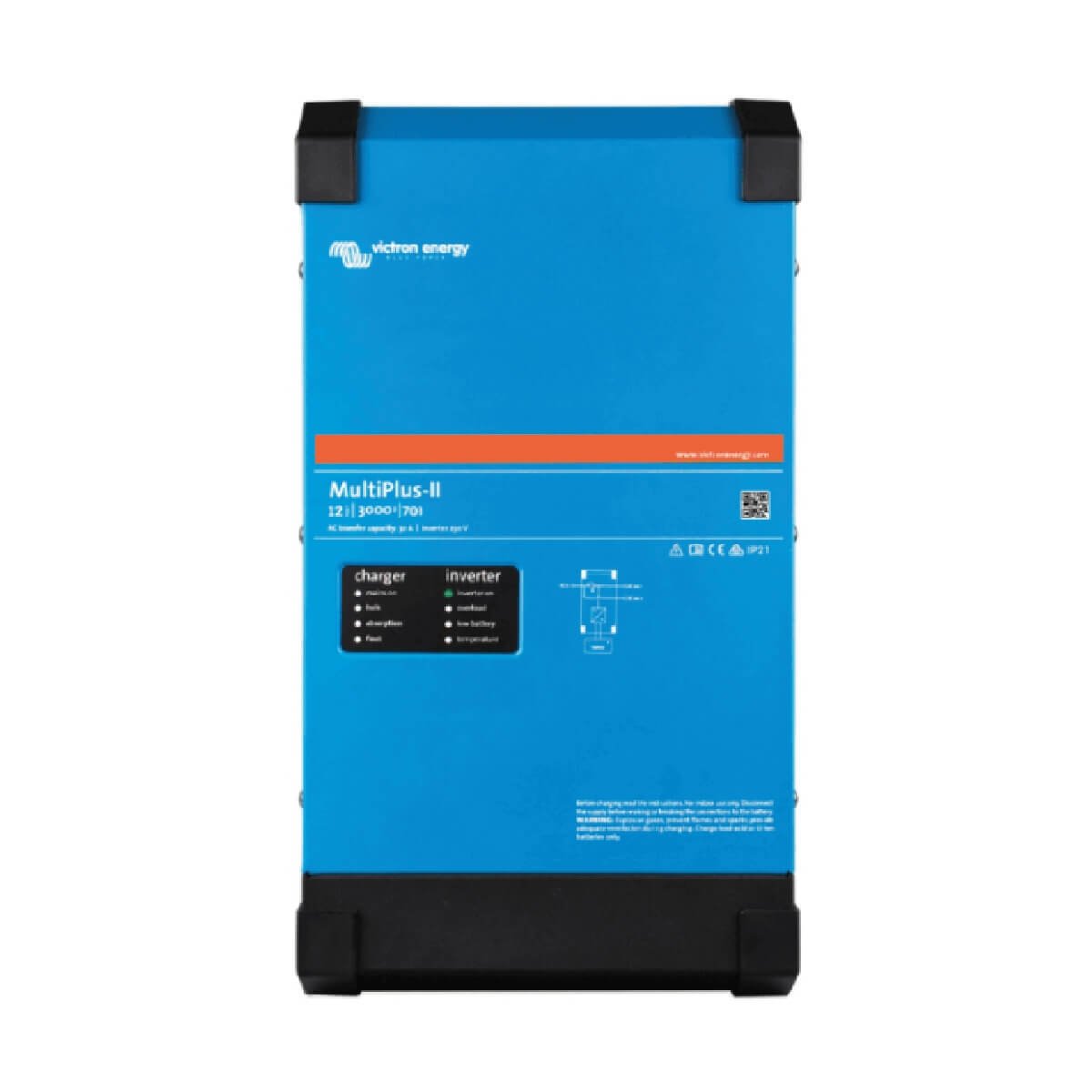
3000VA inverter
When choosing your induction hob and inverter, always be wary of the ‘rated power’ given by the manufacturer. Some induction hobs will have a peak power which is larger than their rated power. Similarly, some cheap inverters won’t be able to handle the power they’re rated to, especially not for long periods of time.
Luckily, Victron inverters are designed to deal with a high surge. Their data sheet also gives a ‘peak power’ rating, and states that they can handle:
- 150% of their rated wattage for 5 seconds
- 130% of their rated wattage for 30 minutes
For more information about how to size your inverter correctly, check out our article: What size inverter do I need for my campervan?
Best single ring induction hob for a campervan
If you want to keep cooking simple, and you don’t have much space in your campervan kitchen, a single ring cooktop might be enough for you. In which case, this single ring induction hob from Sterling Power is a great choice.

This Sterling Power single hob can be fixed into a worktop, where the flush finish keeps it looking really neat. And the small control panel could be fixed into the counter or into the wall above the hob.
At 29cm wide, this hob is best suited for cooking pots with a diameter of 12-20cm. The power setting can be varied from 200W up to 1500W and you can even set a programmable timer to turn off the hob automatically.
Lastly, to power this hob when you’re off-grid, you’ll need a lithium leisure battery and an inverter rated to at least 1600W. However, you should factor in the other appliances you will use, and base your inverter requirements off your total power requirements.
Best double ring induction hob for a campervan
If you want to cook meals quickly and easily, this double ring induction hob from Sterling Power is the perfect addition to your campervan kitchen.
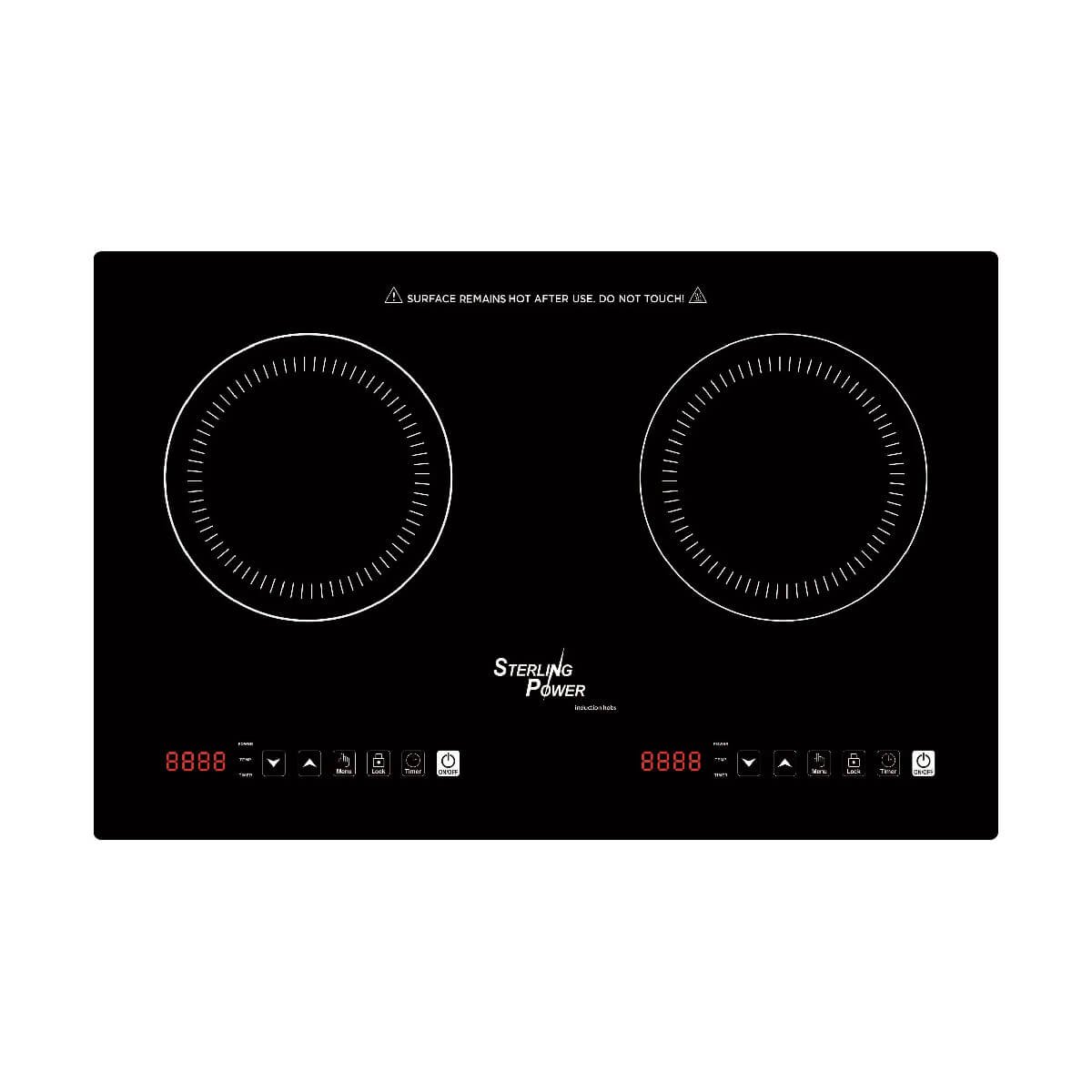

There are two options available: the side-by-side layout, or the front-to-back. So, you can choose whichever layout will work best on your campervan’s worktop. The side-by-side hobs are the same size, but the front-to-back hobs have slightly different power ratings.
Again, each hob has 9 different power settings and a programmable timer which can be set to turn the hob off automatically.
Each double ring hob has a maximum rated wattage of 2800W. Therefore, to use this hob off-grid, you’ll need a lithium leisure battery and a 3000W inverter.
Best portable induction hobs for campervans
If you’re converting a small campervan and don’t have any worktop space to spare, a portable induction hob might be the way to go. This Sterling Power portable induction hob can be set-up quickly and easily whenever you need to cook. It comes with a standard 3-pin plug, so all you need to do is plug it in, and it’s ready to use.

This hob is useful for camping and cooking outdoors, where a portable power station could be used as a source of power. You’ll just need to make sure the power station has a large inverter and a big battery bank to handle the big power usage. You will need at least a 1600W inverter to power this hob.
The diameter of the cooking surface is approx. 28cm, so will work best with pots which are 12-20cm in diameter.
Campervan induction hob FAQs
-
Unfortunately, there are no 12V induction cooktops currently on the market. However, you can power a 230V induction hob from a 12V lithium leisure battery using an inverter.
-
You can install an electric hob in a campervan. Low wattage induction hobs can be powered from mains hook-up at a campsite, or from a lithium leisure battery when you’re off grid.
-
Portable induction hobs can use anywhere from 3 amps to 13 amps from mains power (230V AC). The amount of current used will depend on the power rating of the induction hob. For example, a 1500W portable induction hob will draw around 6.5A from 230V power, which will equate to 125A from a 12V leisure battery.
-
Portable induction hobs can be powered from a 13A plug socket, provided they are rated below 3000W. For example, this ‘plug and play’ induction hob from Sterling Power has a maximum power rating of 1500W, which would equate to 6.5A at 230V.
-
Induction hobs operate at 230V, the same voltage as mains power in the UK.
-
Portable induction hobs are, arguably, safer than gas hobs when it comes to cooking in a campervan. There is no open flame, so the potential for loose clothing or curtains to catch fire is greatly reduced. Furthermore, good-quality induction hobs will have built-in electrical safety features. For example, Sterling Power induction hobs have an over-heat, over-voltage and over-current protection mechanism.
-
Yes, you can power an induction from a portable power station, provided the inverter is larger than the rating of the hob. However, induction hobs use a lot of power, so even a large power station will be depleted fairly quickly. For example, a 1260Wh power station would only be able to power a 1500W induction hob for around 50 minutes.
How to convert a campervan
Want to know exactly how to convert a campervan? Our 331 page bestselling book, The Van Conversion Bible, covers all aspect of a van conversion, from planning your layout to a step-by-step build guide.



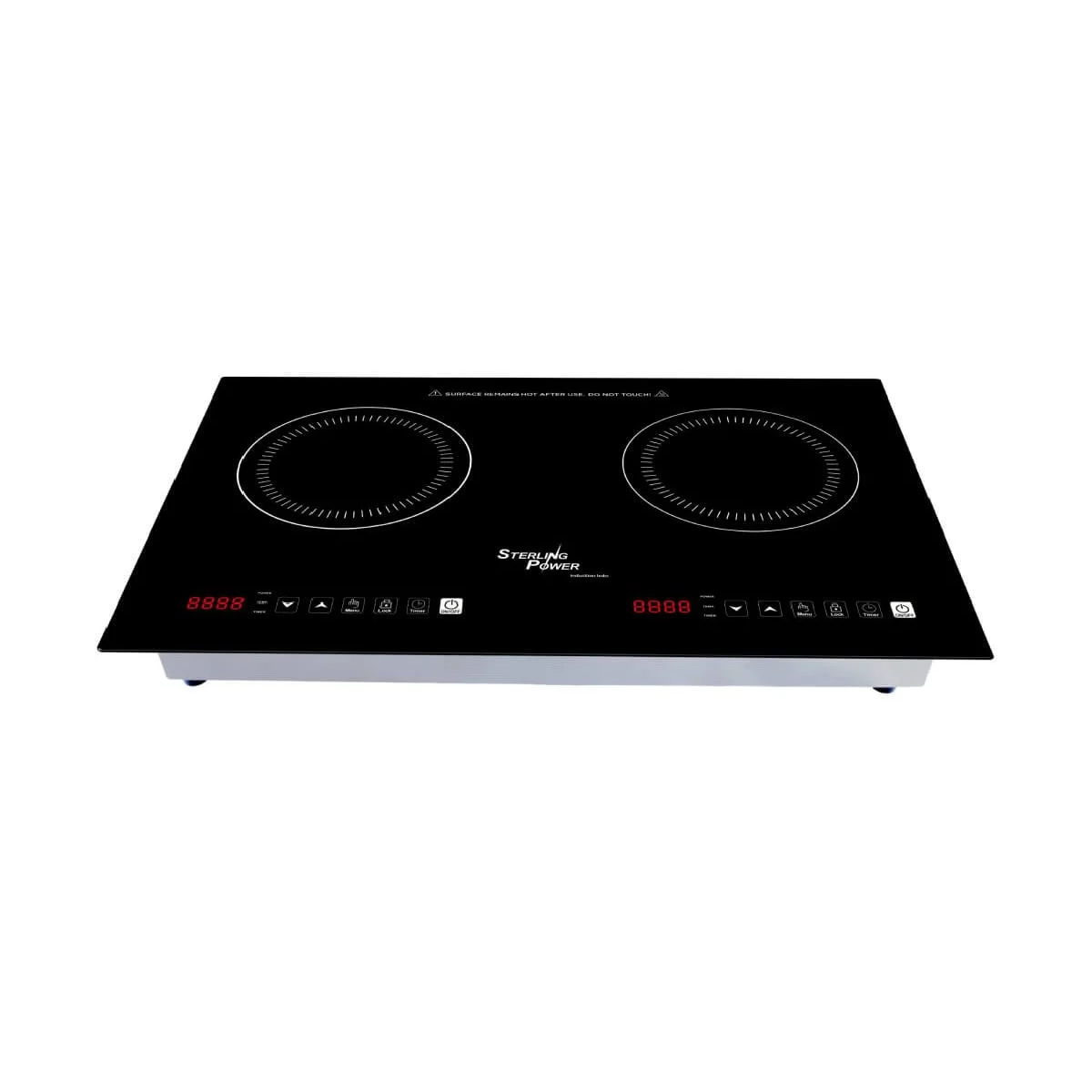
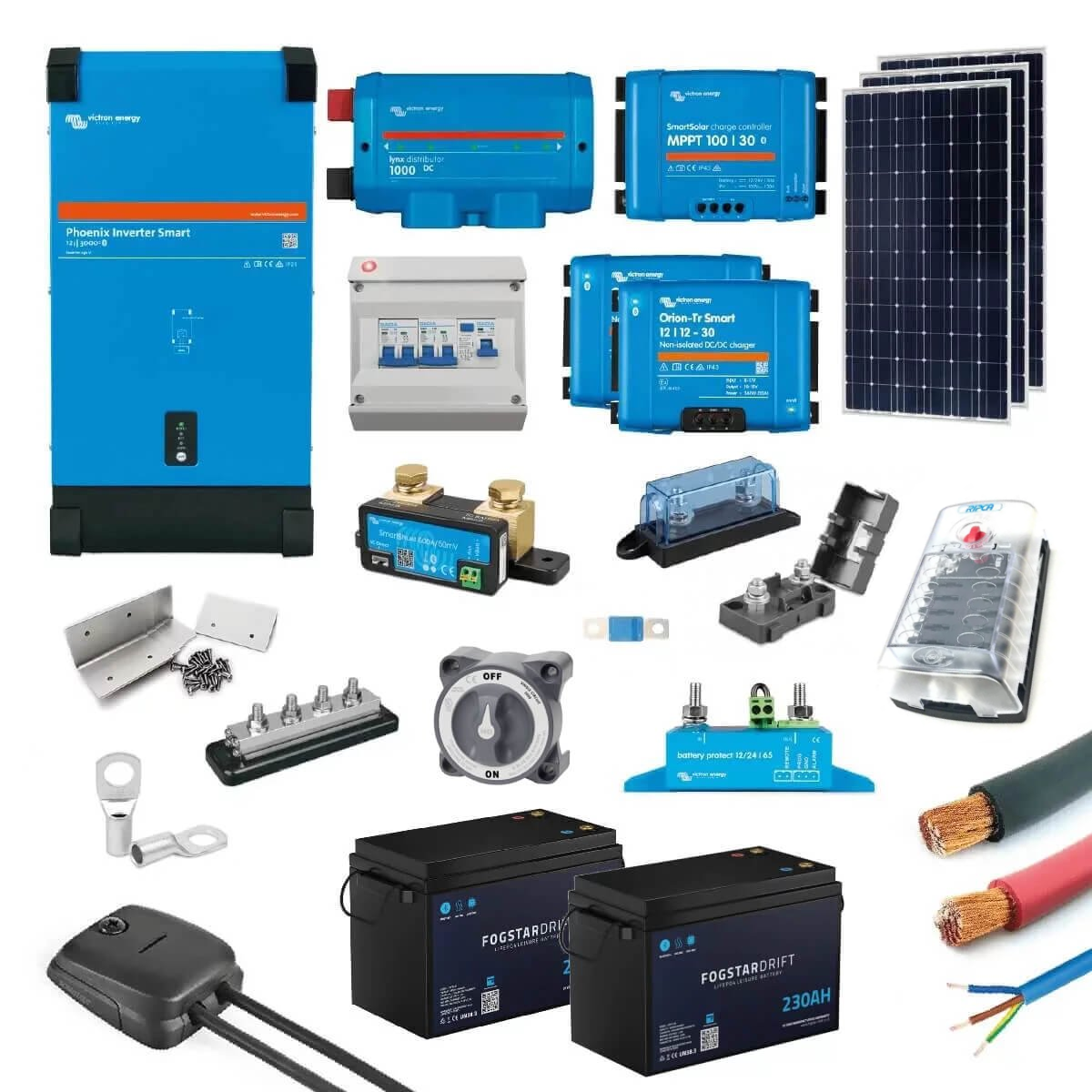
 Wiring diagram included
Wiring diagram included

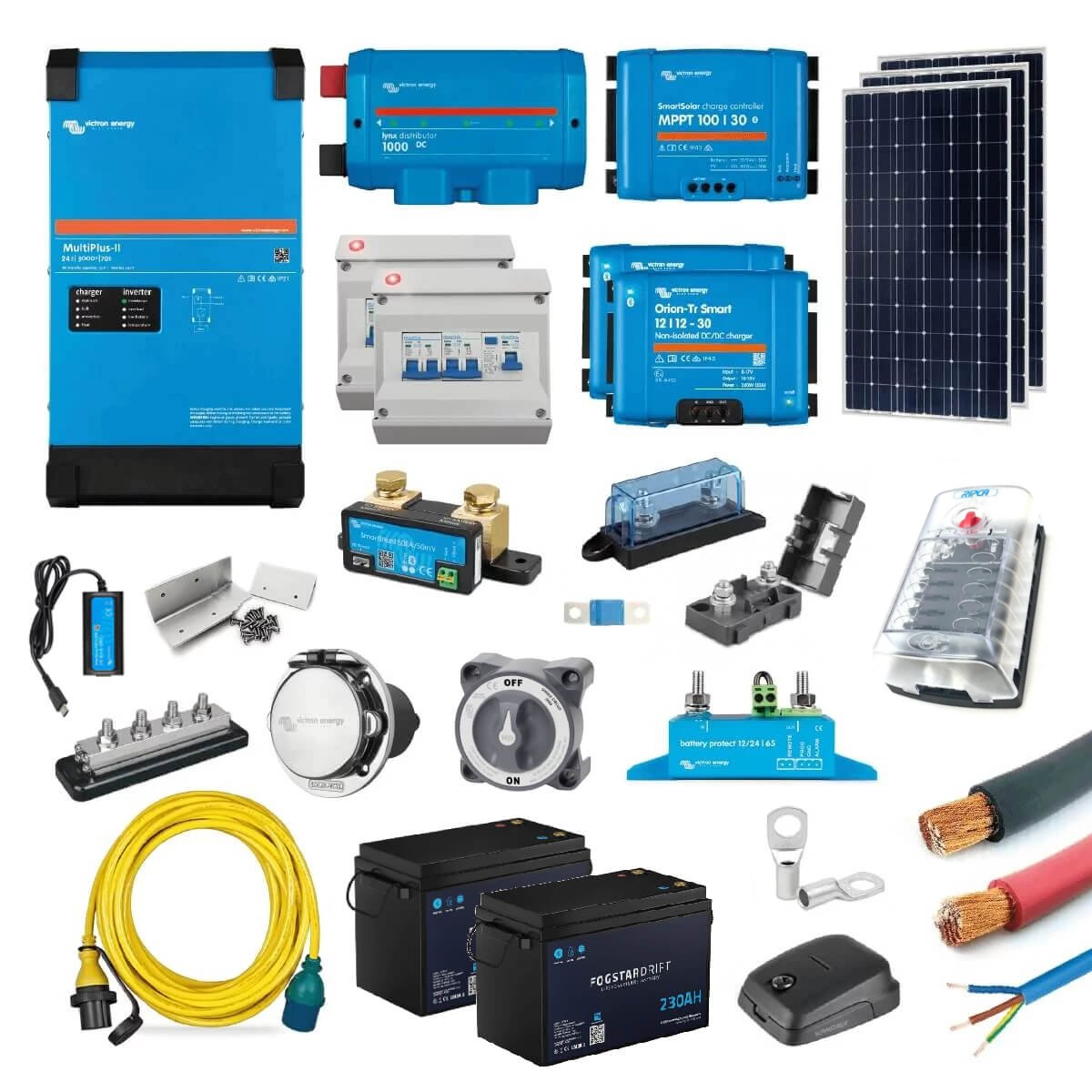
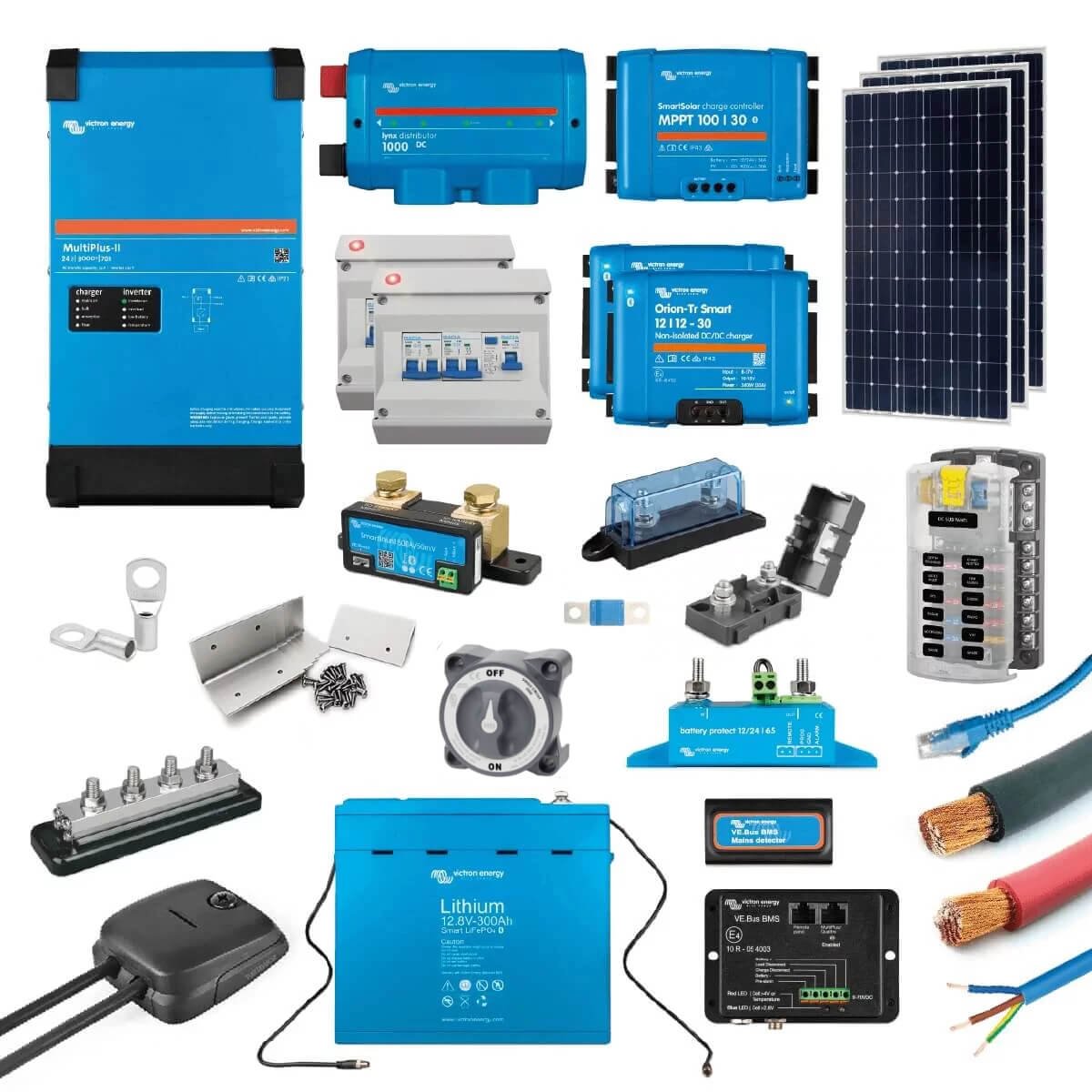
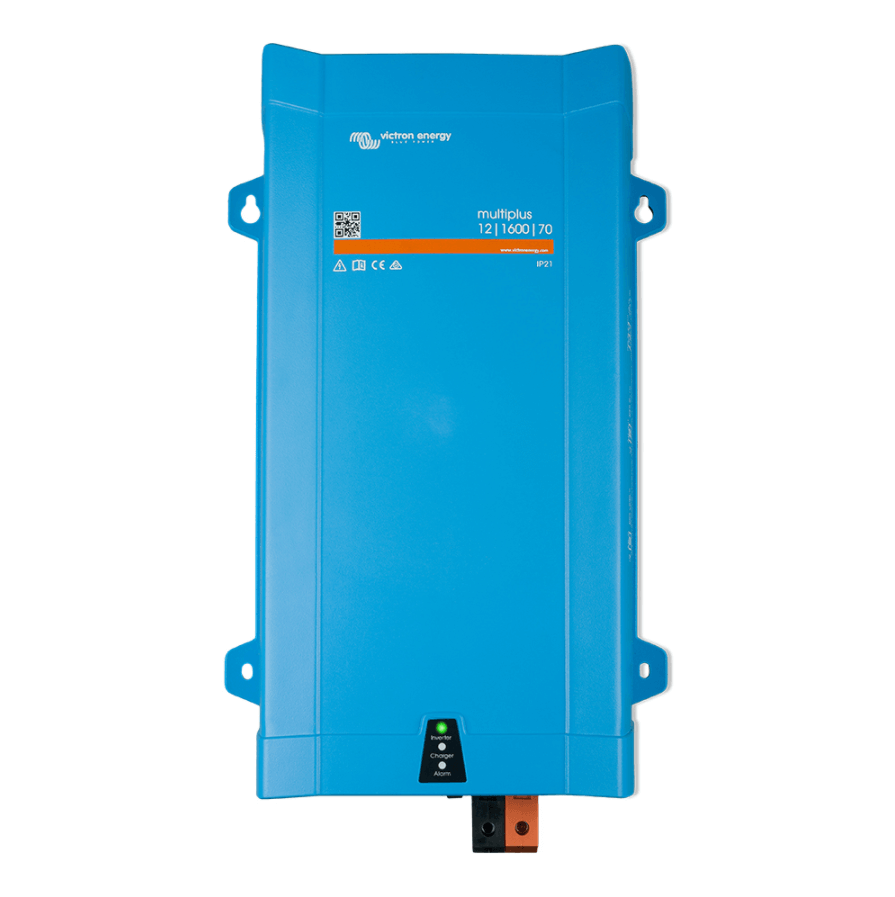
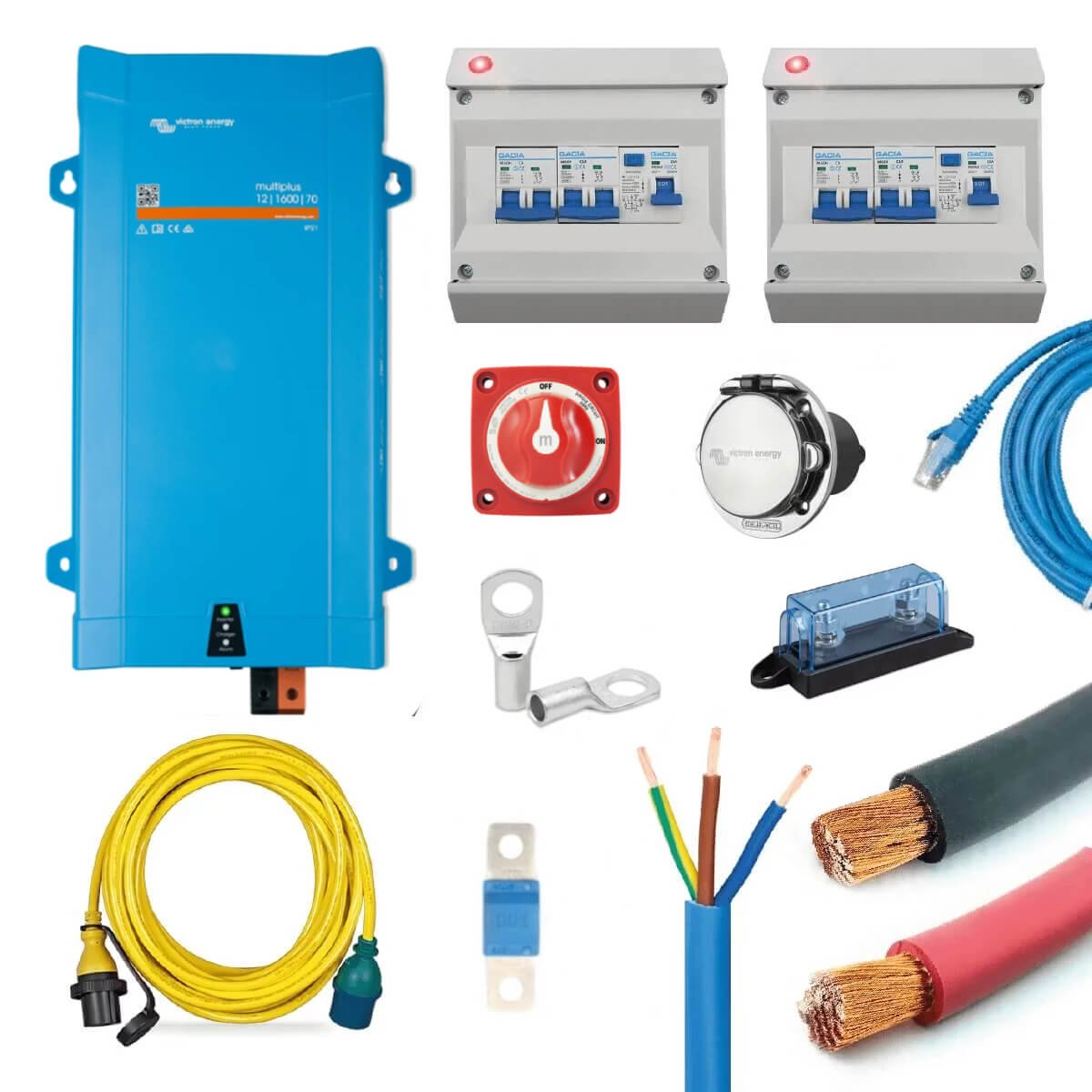
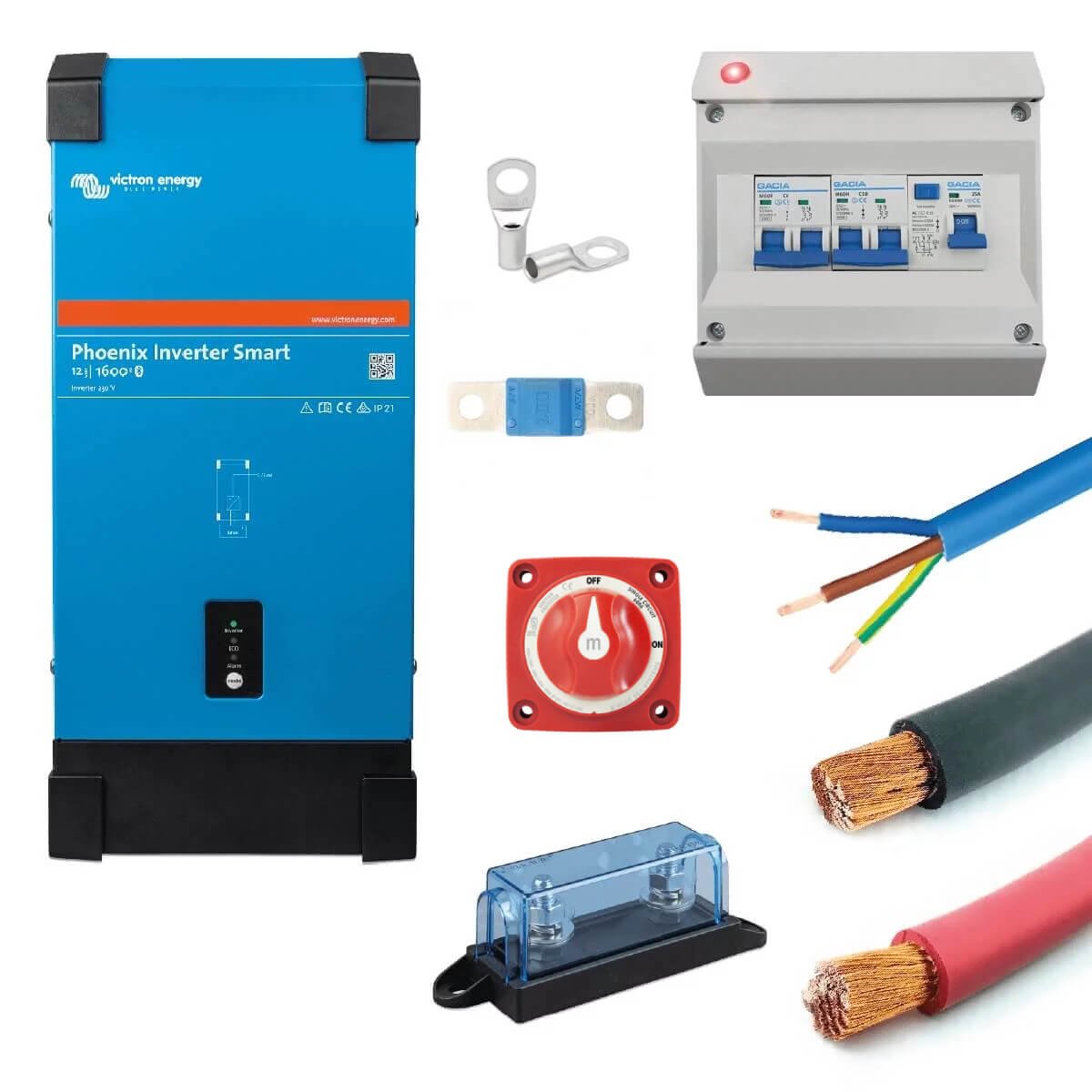
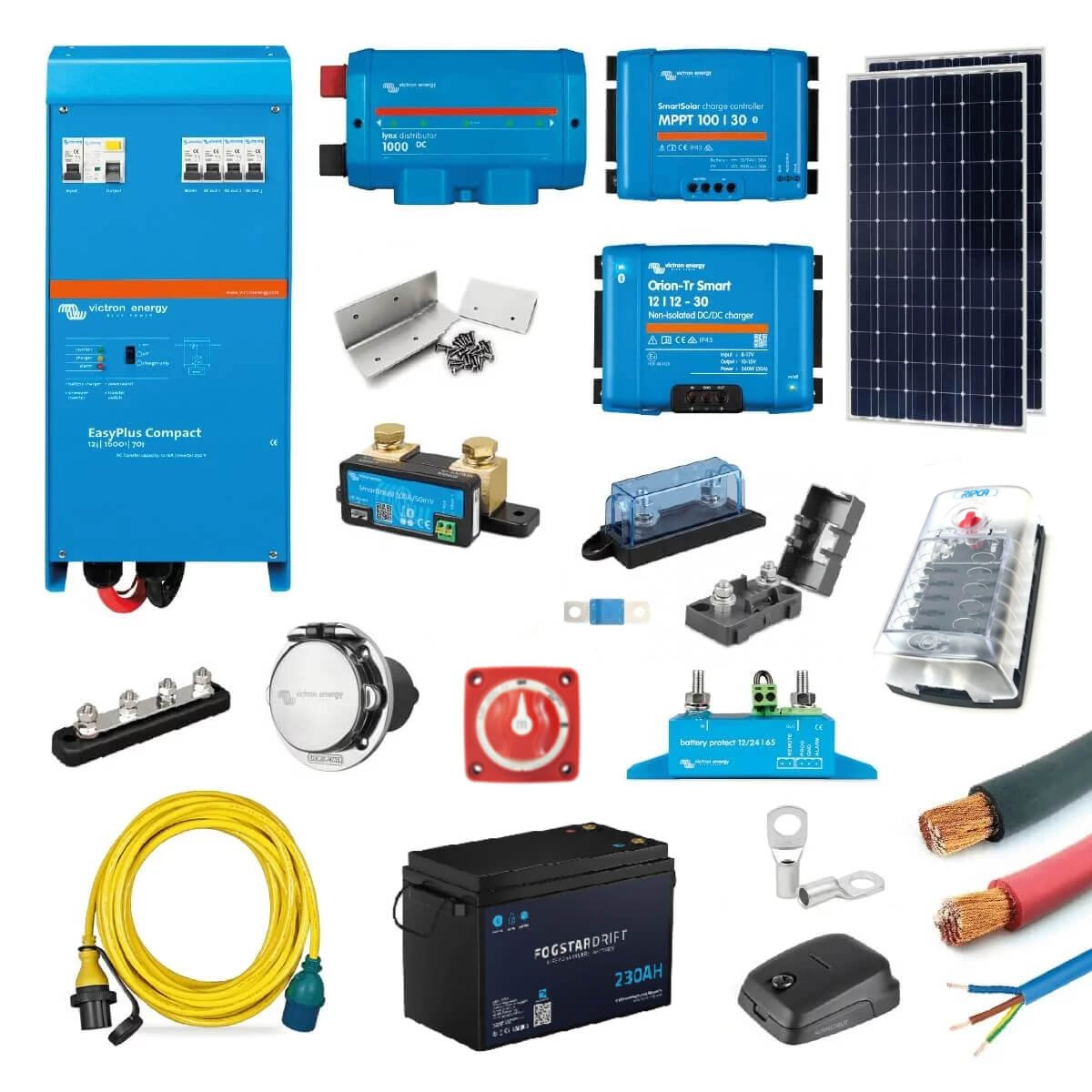

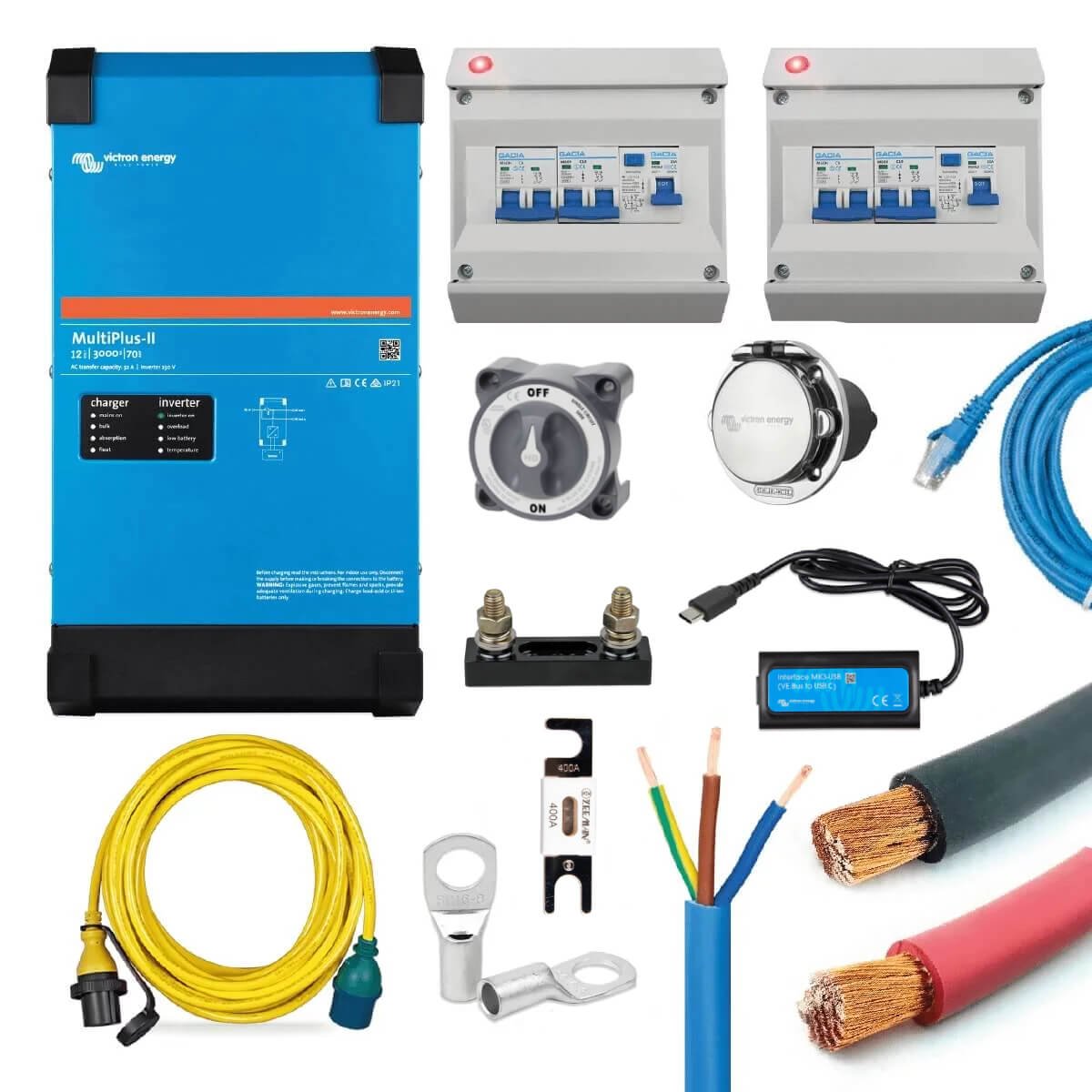

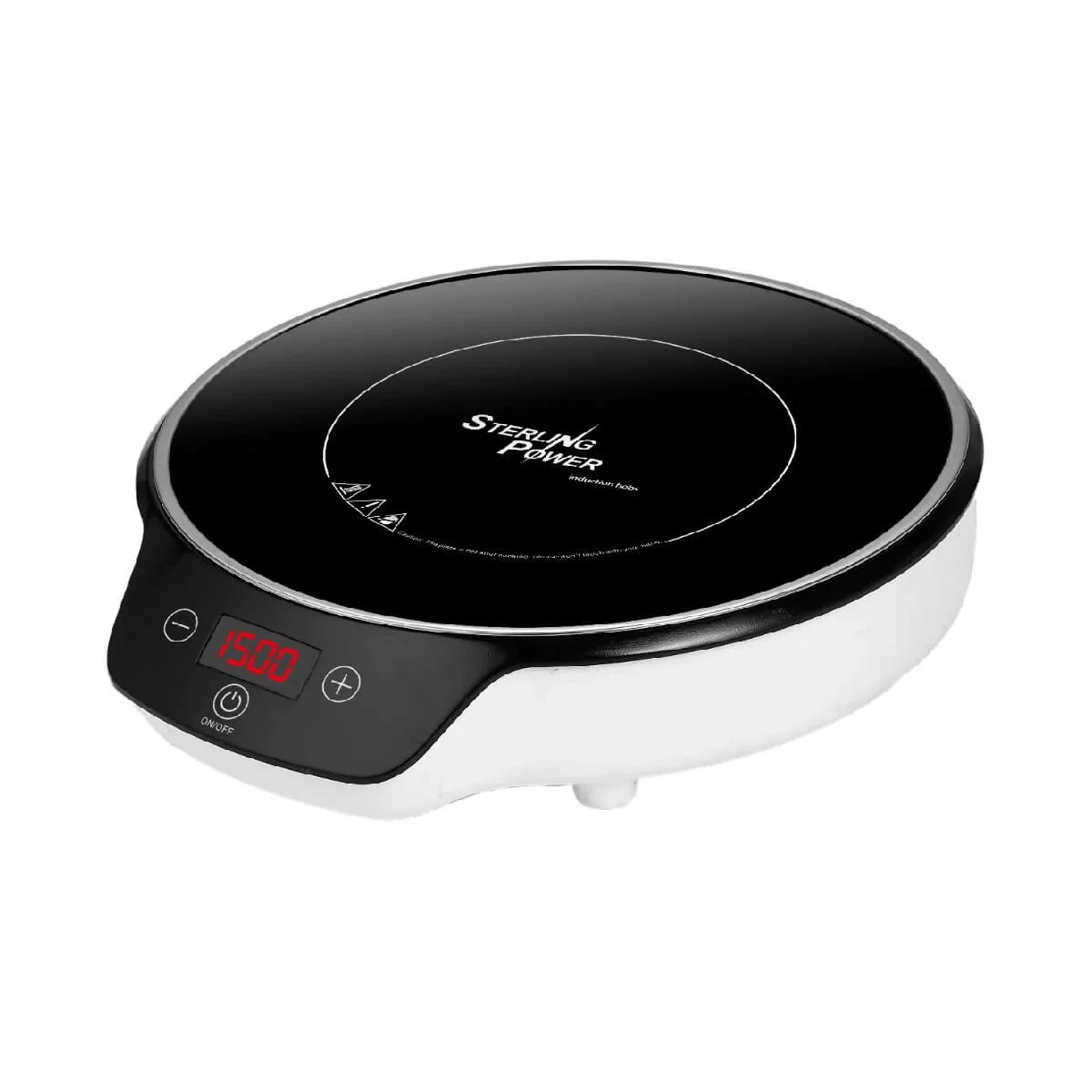
Very interesting, but to charge such a large bank of batteries what 230v and 12v charging system would you recommend
Hi John, there are a lot of different parameters to consider when deciding how to charge your electrical system, such as how long you will spend off-grid at a time, if you will spend time on campsites, how much driving you will do, the climates you will travel in etc. If you want help designing your campervan electrical system, you might find our electrical design service Nomadic Energy useful. Thanks!
Hi, you should also detail the charging power available from a high power battery to battery charger and the limitations of some batteries to accept a higher charge rate.
Perhaps compare 20,30 and 40ah chargers
Reds
Tim
Hi Tim, we have a separate article about battery to battery chargers, and an article about lithium leisure batteries. We’re also planning on writing about AGM vs lithium at some point soon. Thanks!
I have looked online at normal house induction hobs and there are a number of induction hobs rated at 2.8kw. I have 2 home made 560ah lithium batteries giving me a total of 1120ah. I have 720watts of solar panels on my roof and I am thinking of getting rid of my satellite dish and putting another 400 watt solar panel. I have victron mppt controllers and victron battery shunt and a Sterling 60amp b2b charger. Would I be able to use these 2800 induction hobs I see at b&q or currys. My only problem is I have only got a Sterling 2.5kw inverter charger but I wouldn’t be using all 4 rings at the same time.
Hi Mike, you have a couple of considerations when purchasing an induction hob. The first is the ‘constant wattage’, and the second is the ‘peak power’. The peak power of a domestic induction hob can be up to ~170% of their total rated wattage. This means that a 2800W induction hob could pull up to 4760W on start up. Even if you’re not using it on max, there’s a chance that it will still draw the max power on start up, so you may well see this high peak. You will therefore need an inverter which can deal with this. The Victron inverters can provide 130% of their rated wattage for up to 30 mins, so for example the 3000W inverter can provide 3900W for up to 30 mins.
Campervan induction hobs which have been designed for use in an off-grid system such as the Sterling induction hobs tend to work differently. These don’t have the same peak power on startup. We would recommend looking at one of the Sterling double ring induction hobs for this reason.
I already have in my van 400Ah of 12v lithium and a Victron Multiplus II 12/3000. This should be plenty for a day or three off grid with light use.
I note the the Sterling is useful because it’s a ‘slow start’ switch on. Are there any others like this to choose from, for comparison? Also, when set at half power, does the Sterling draw half the power, or full power for half the time? This could be important if close to the inverter’s maximum output.
Hi Mike, the Sterling induction hobs are the main range of campervan induction hobs available. I believe Thetford also have a couple of options. I believe the Sterling hobs draw half the power, as the lowest power setting uses 400W of power.